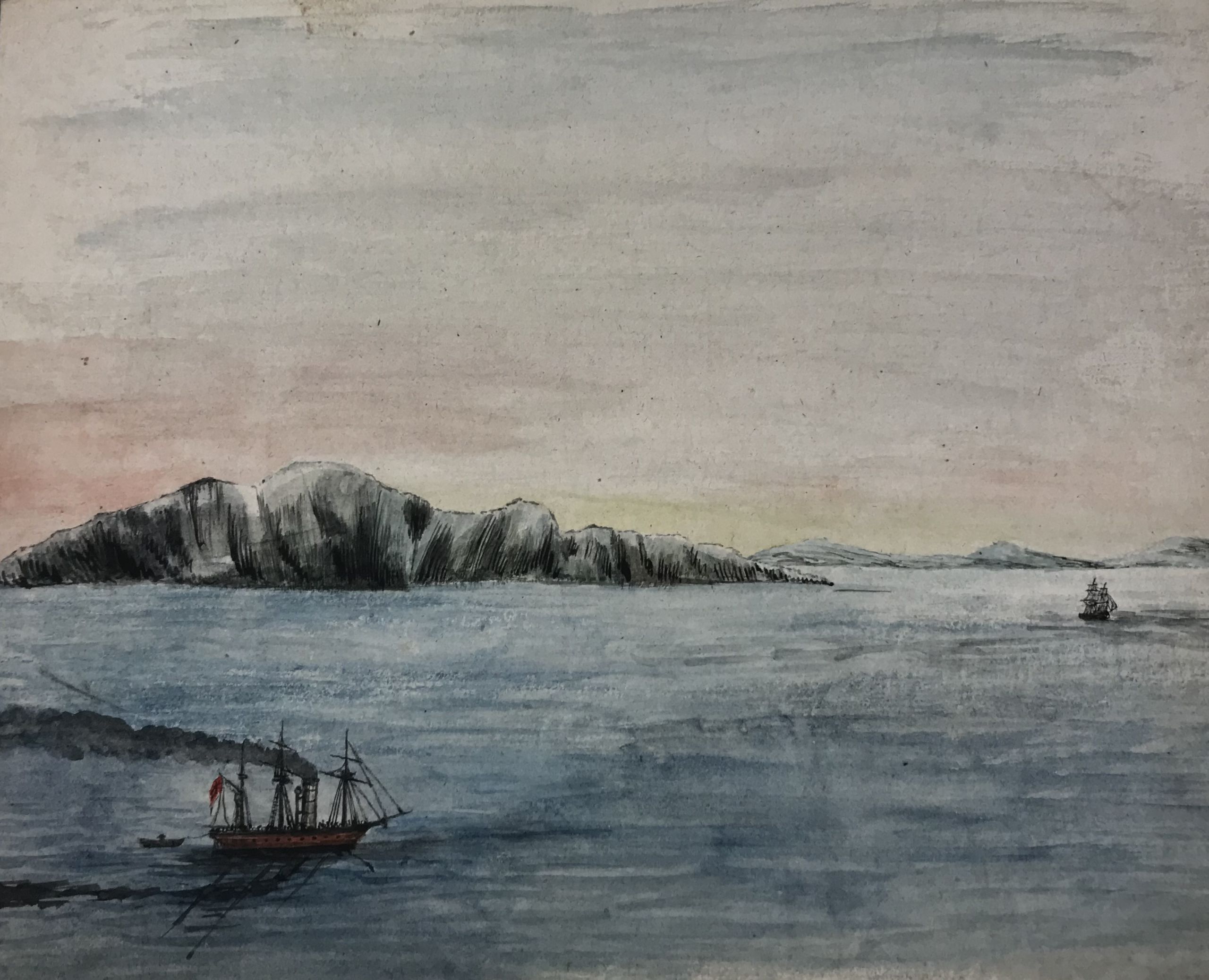Preparing
for Journeys
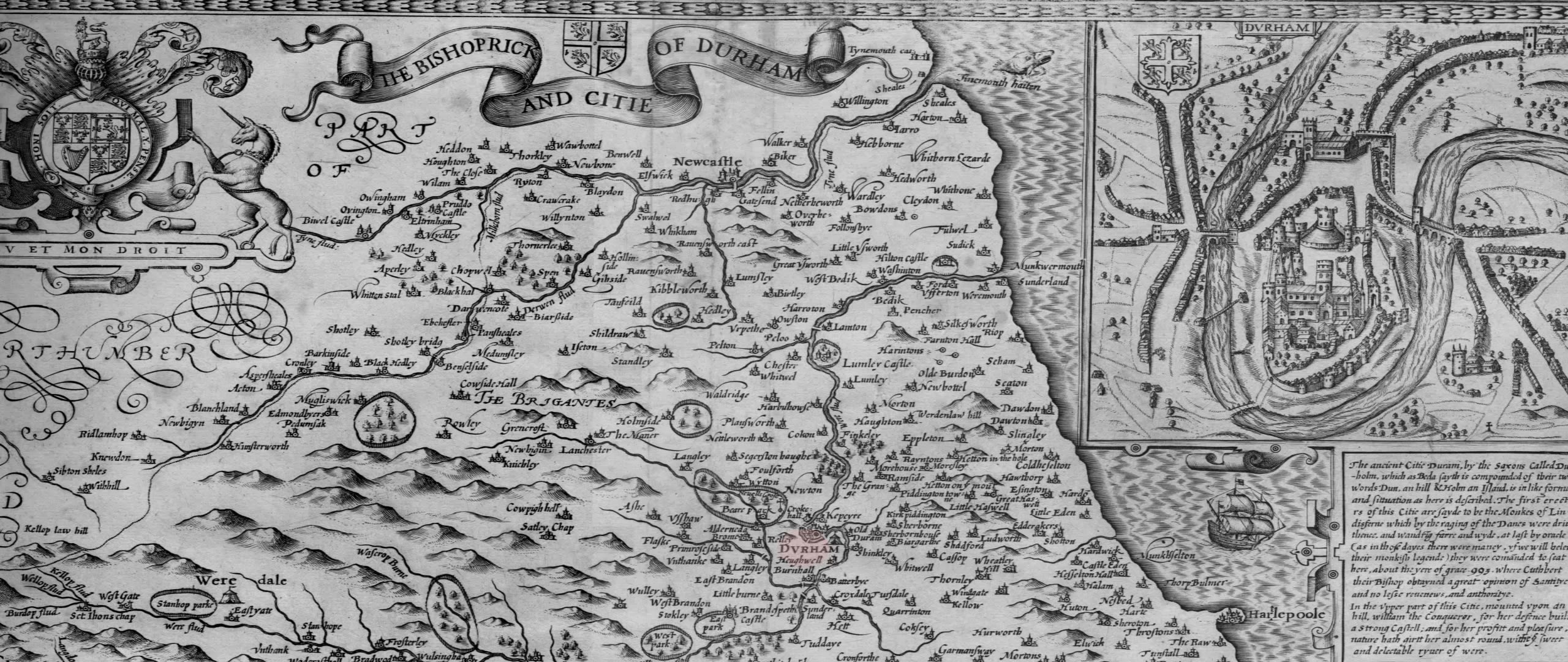
Using the books, archives and manuscripts from Durham University’s special collections, this exhibition will explore the ways people have planned and prepared for journeys throughout history and the written works that have paved the way for the travel resources we are familiar with today.
Whether you are an armchair traveller or already packing for your next trip, leave your home, work and troubles behind as you come with us on this journey.
Attention Spotify users: why not listen to our exhibition playlist while you explore.
The true voyagers are those who leave just to be leaving... And without knowing why, they always say: "Let's go!”
Charles Baudelaire, Le Voyage
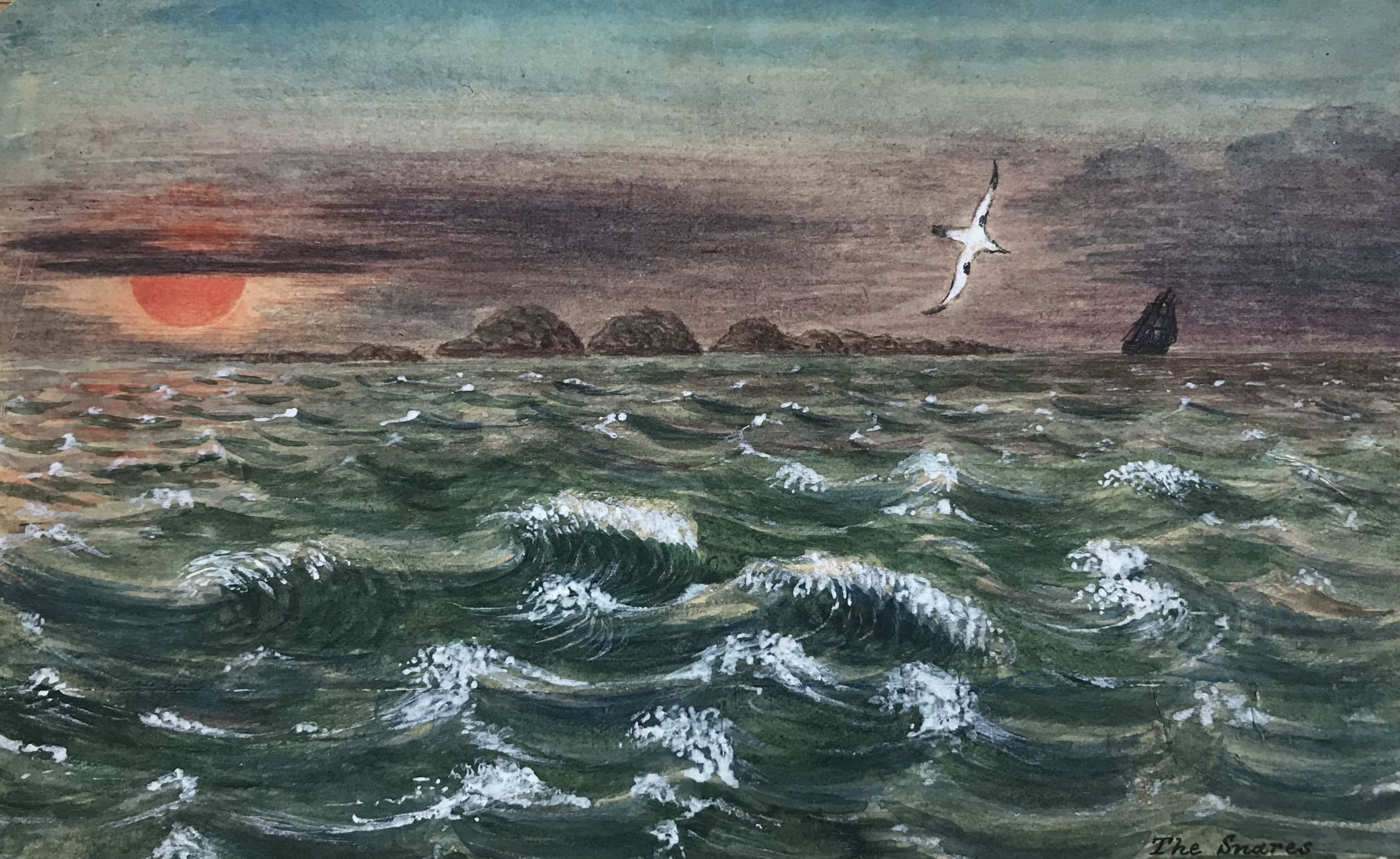
Why
Travel?
The reasons we travel are vast and complex, often driven by curiosity, desire and the lure of the unknown.
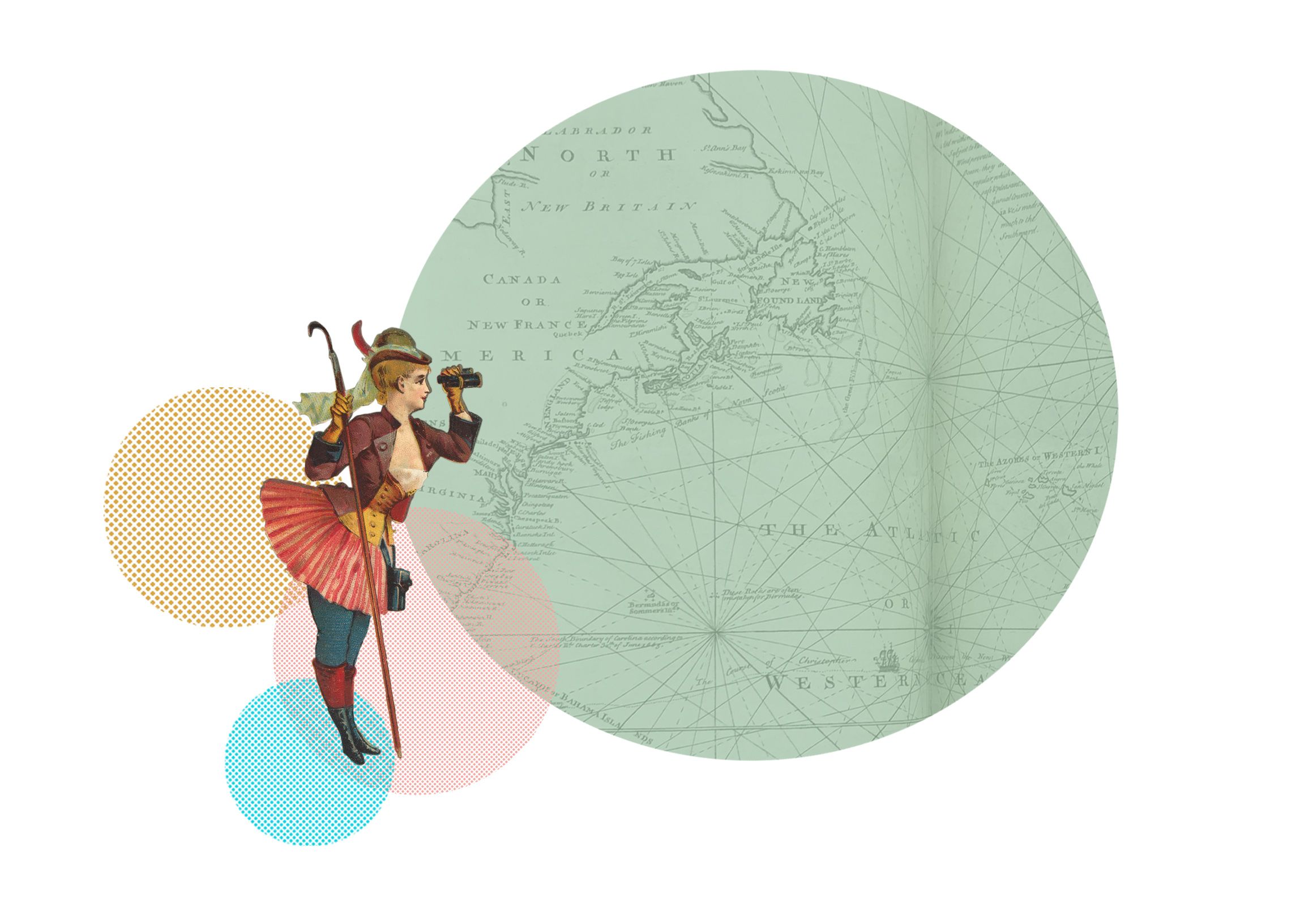
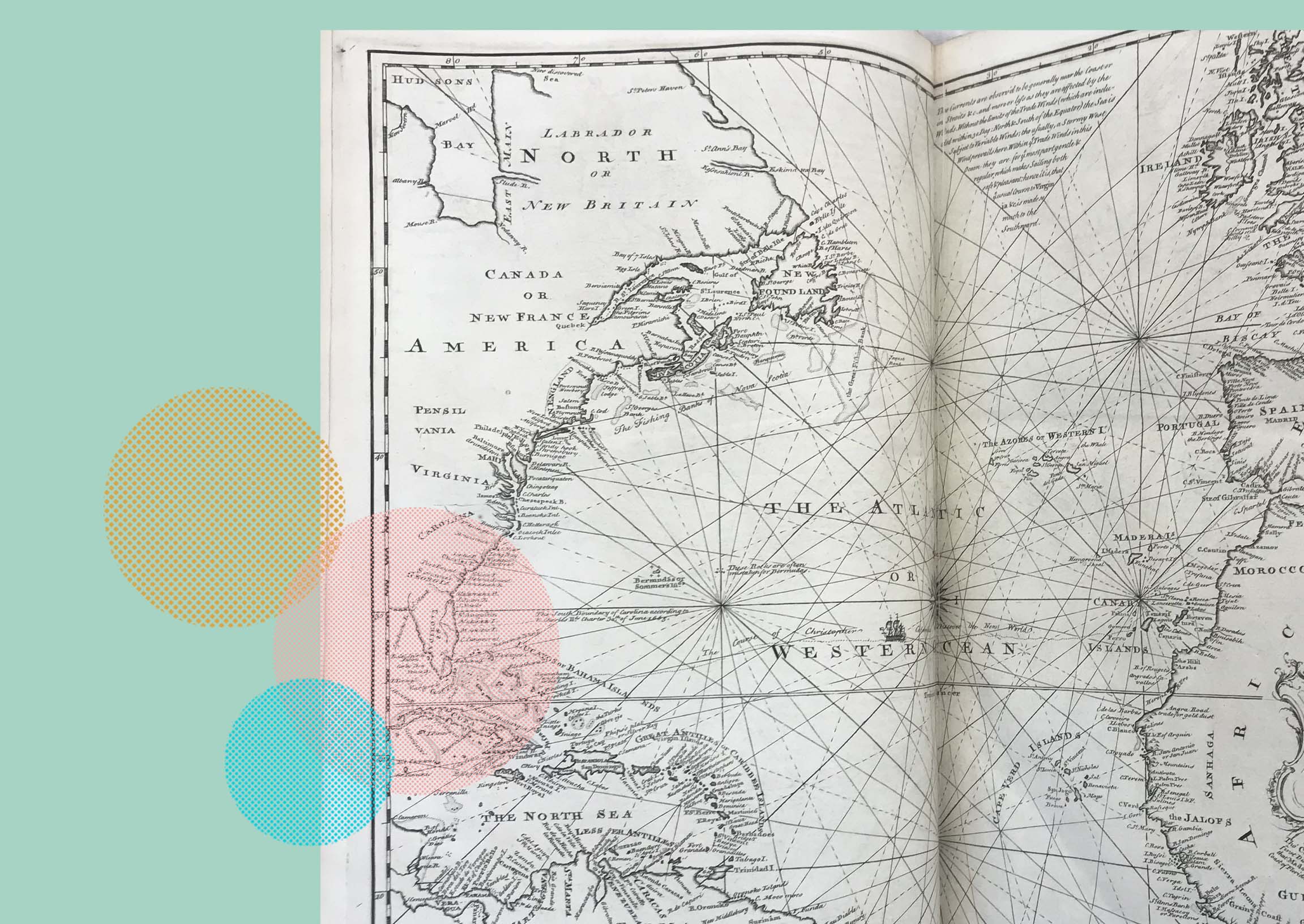
Usually seen as something positive, today travel offers a chance for relaxation and reinvention, philosophical growth and getting a tan.
This view was not always common. As foreign travel expanded in the 1600s - 1700s, debate raged over its value and the reasons for making these journeys.
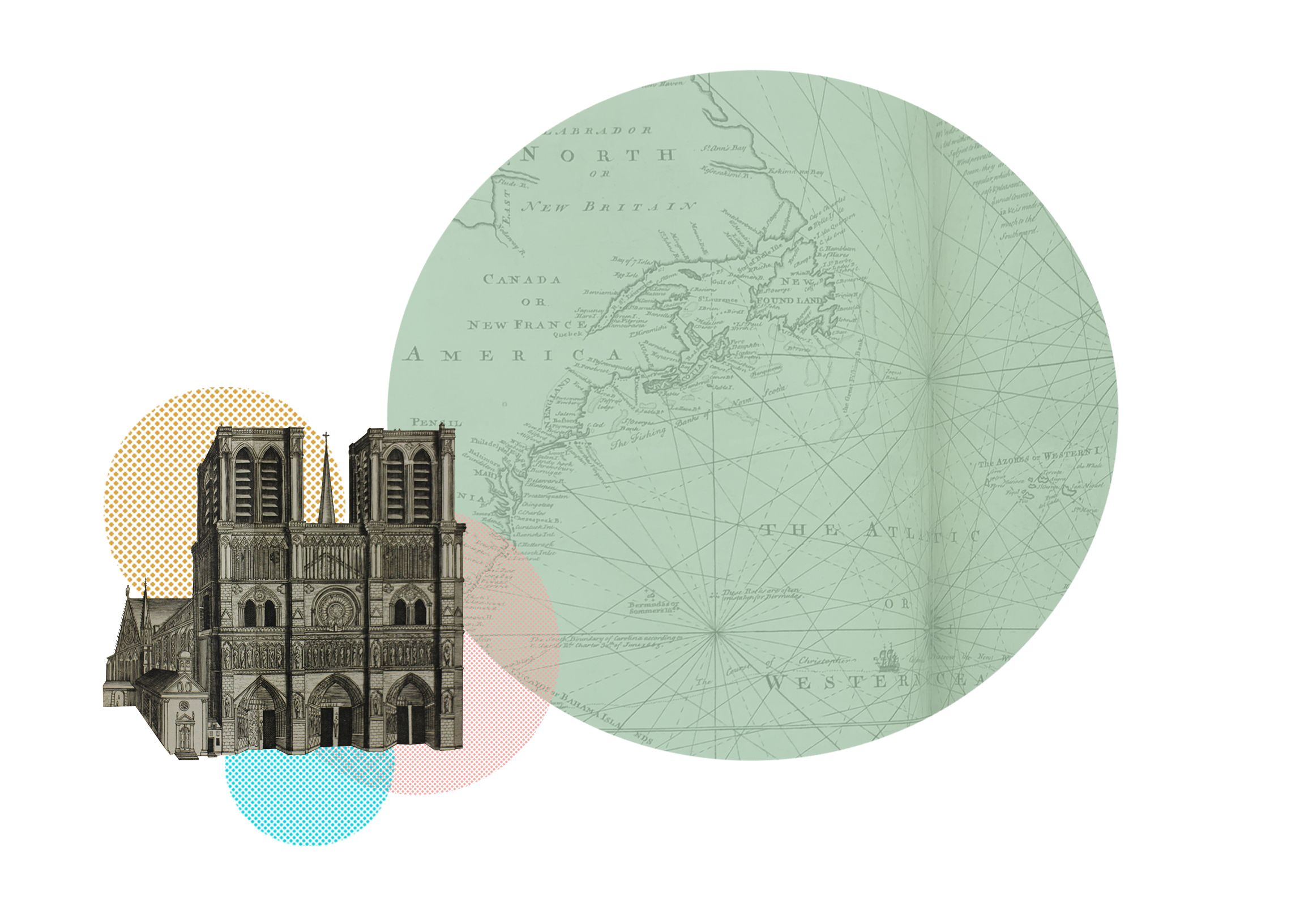
Learning Life Skills
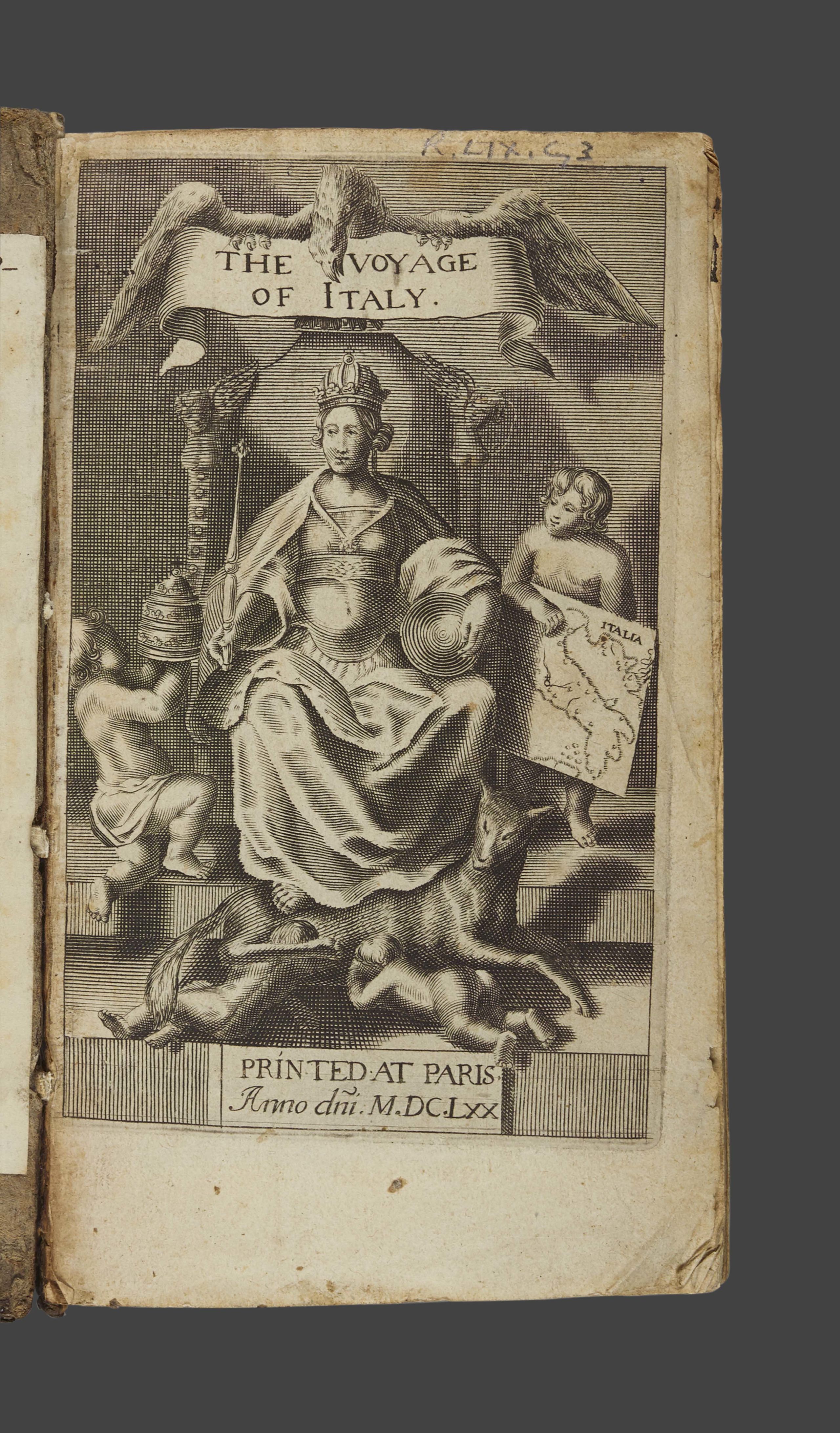
Considered one of the most influential English guidebooks of its time, this work warns that travel should never be just for pleasure.
For Lassels, the life skills young travellers acquired made them less dependent on their parents and increased their economic and political prospects. Travel also offered the opportunity to build an international community, meaning the skills gained by the traveller would benefit society as a whole, not just individuals.
Richard Lassels, The voyage of Italy, or A compleat journey through Italy. Newly printed at Paris: and are to be sold in London, by John Starkey at the Mitre in Fleet Street near Temple-Barr, 1670. Routh 59.G.3
The Right Reasons for Travel
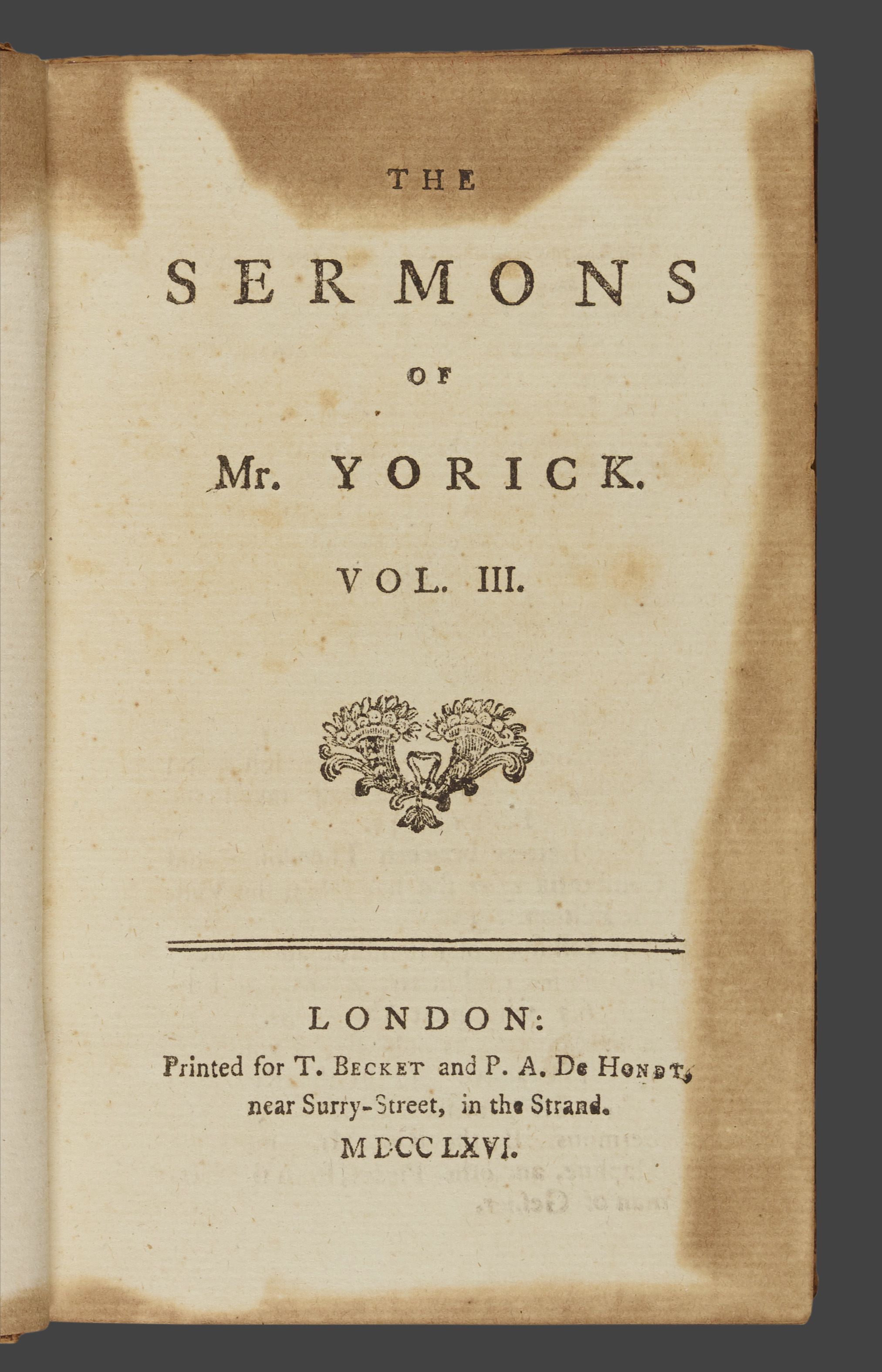
Sterne’s sermon on travel highlights some of the main reasons people choose to make journeys: the love of variety, the curiosity to see new things and the chance for progress through acquiring knowledge of foreign cultures. As long as people travelled for the right reasons, it could be a positive and enriching experience.
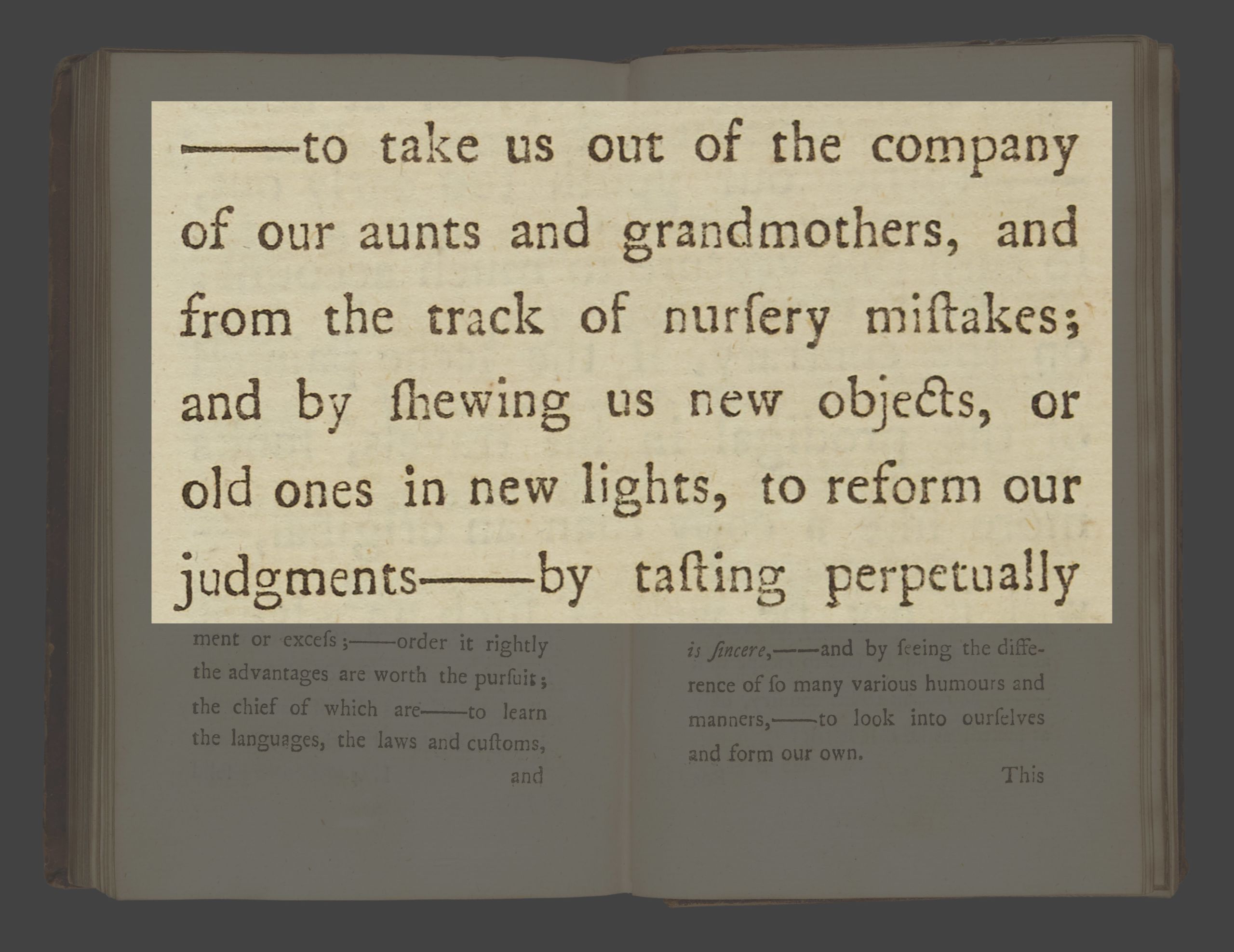
Laurence Sterne, The sermons of Mr. Yorick, volume 3. London: Printed for T. Becket, and P.A. De Hondt, near Surry-Street, in the Strand, M DCC LXVI [1766]. SC 08234
Questioning the Value of Travel
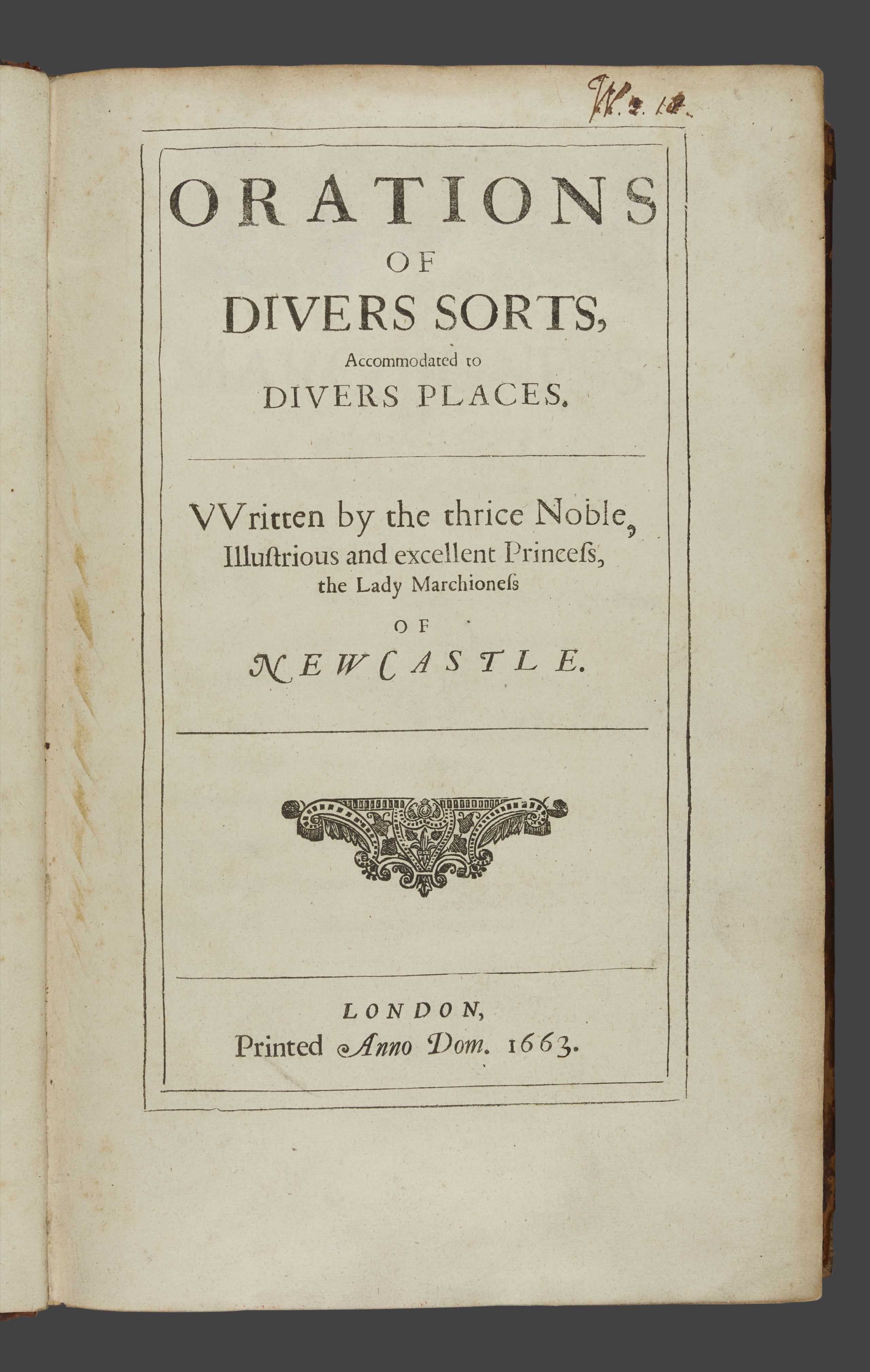
Cavendish’s writing reveals how foreign travel in this period was mainly available to upper class young men, but questions what they gain from the experience. Her critical attitude suggests that she was not impressed with the behaviour of these travellers and writes that they should be tested on the knowledge they have acquired when they return home.
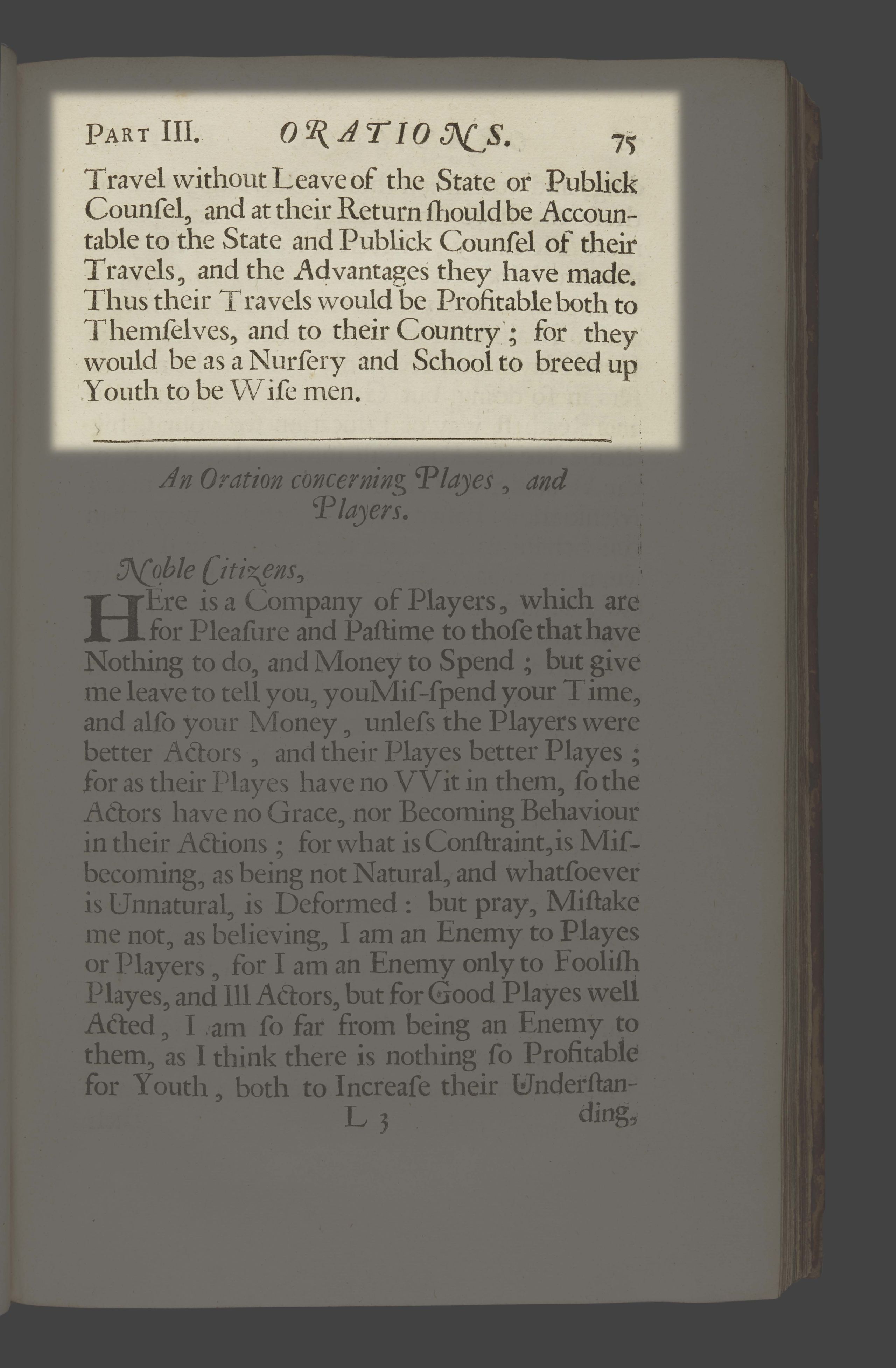
Margaret Cavendish, ‘An oration concerning the foreign travels of young gentlemen’, from Orations of divers sorts, accommodated to divers places. London: [publisher unknown], 1663. Cosin W.3.18
For Business or Pleasure?
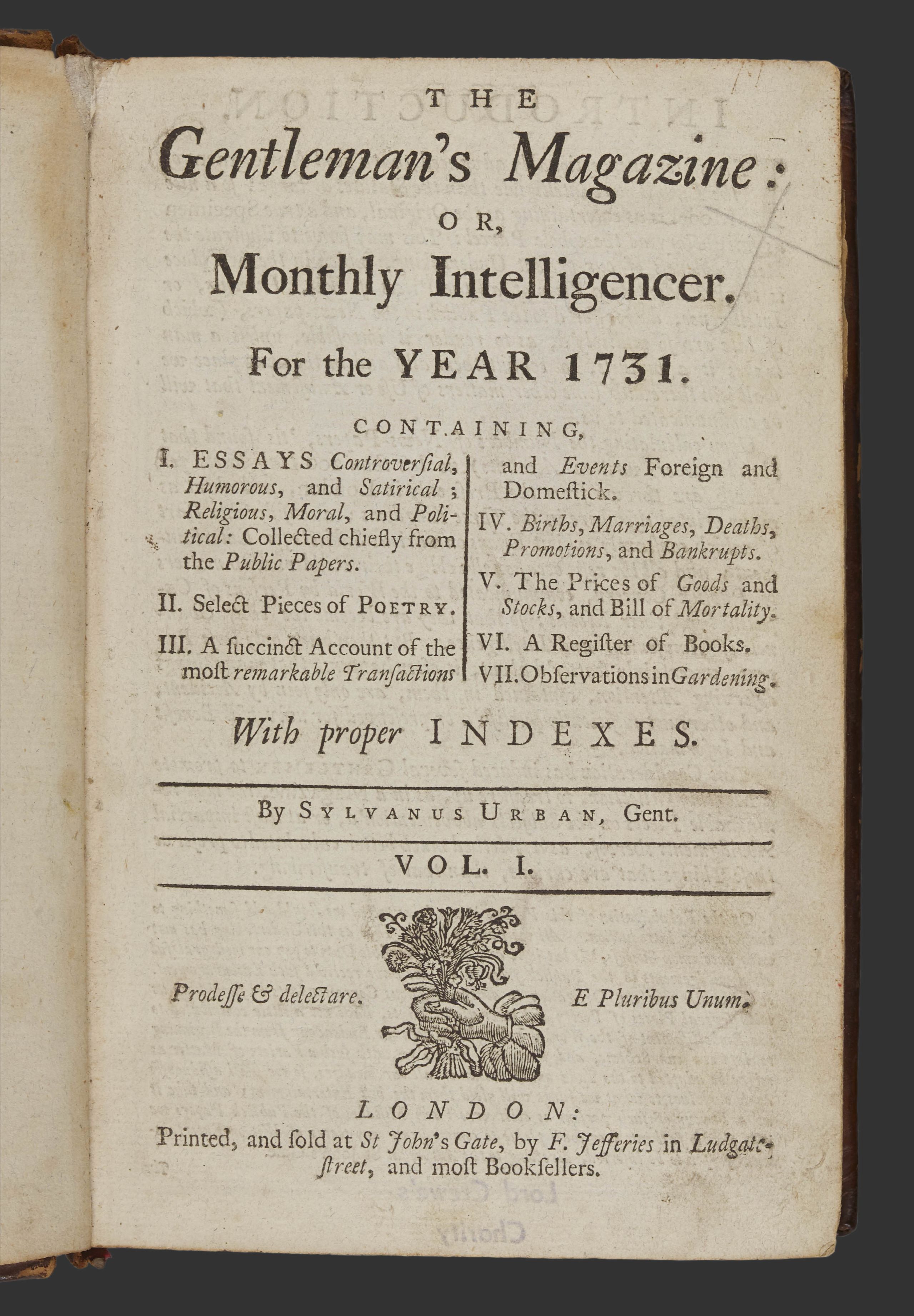
Almost 70 years on from Cavendish’s oration, this letter reiterates concerns about the corrupting nature of foreign journeys, though it does highlight the value of travel for business.
It appears in the first volume of the long-running Gentleman’s Magazine, which is now an important source of information about the society, politics, and culture of England in the 1700s. The publication drew together information from many different sources and frequently included articles on travel.
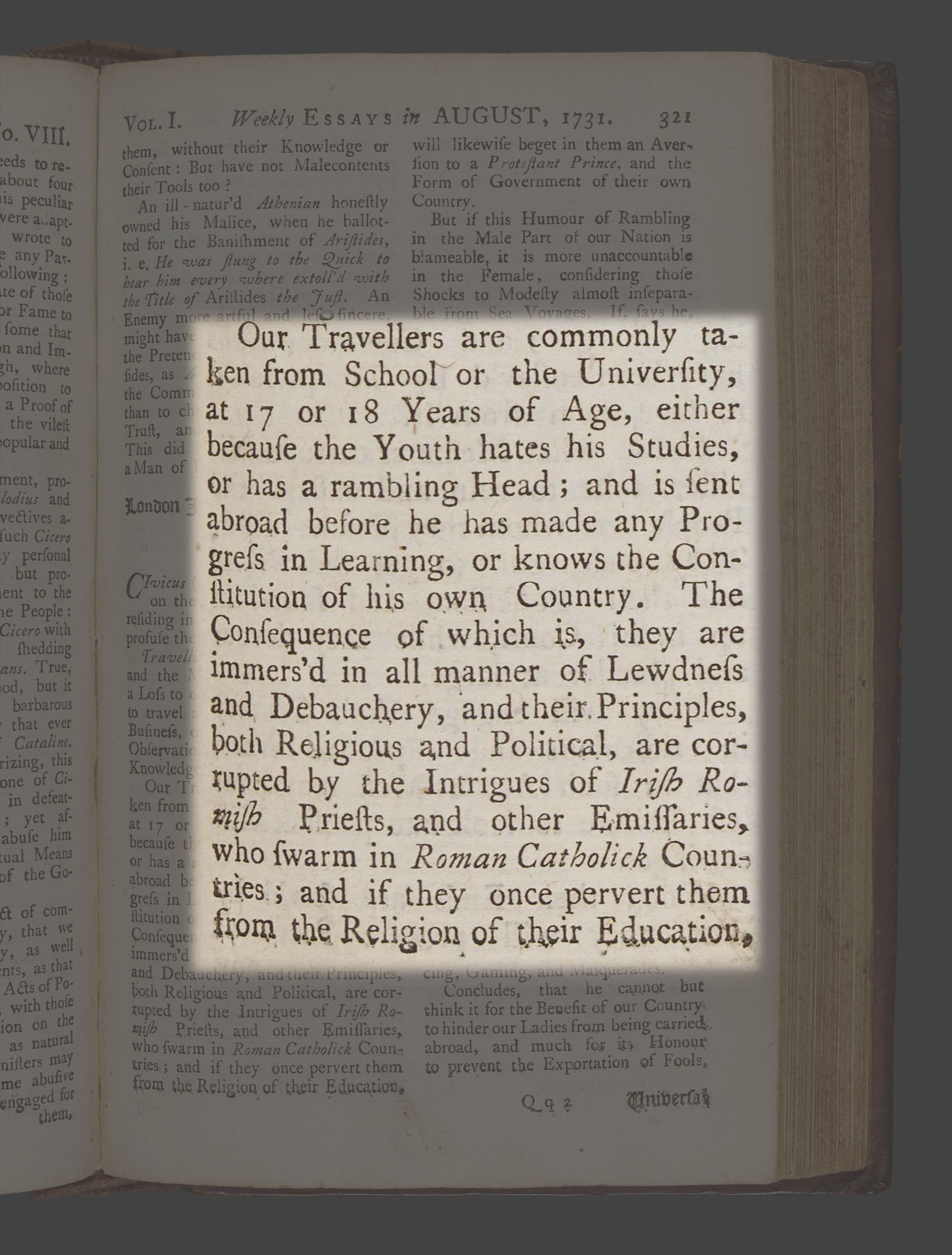
“Civicus” ‘Of travelling’, Gentleman’s Magazine: or the Monthly Intelligencer. For the year 1731 … By Sylvanus Urban, Gent.London: Printed and sold at St John’s Gate by F. Jefferies in Ludgate Street, and most Booksellers, 1732. Bamburgh P.3.78
Reproduced by permission of the Lord Crewe Trustees







Dos and Don'ts
of travel
Even hundreds of years ago, no one wanted to be that tourist: stuck in bad accommodation, missing out on the best food, or bringing the wrong clothes for the destination.
In the days before online reviews and Instagram inspiration, savvy travellers often needed to consult a variety of sources to ensure they were prepared for their journey.
Here are the Top 3 Dos and Don'ts for would-be travellers from our collections.
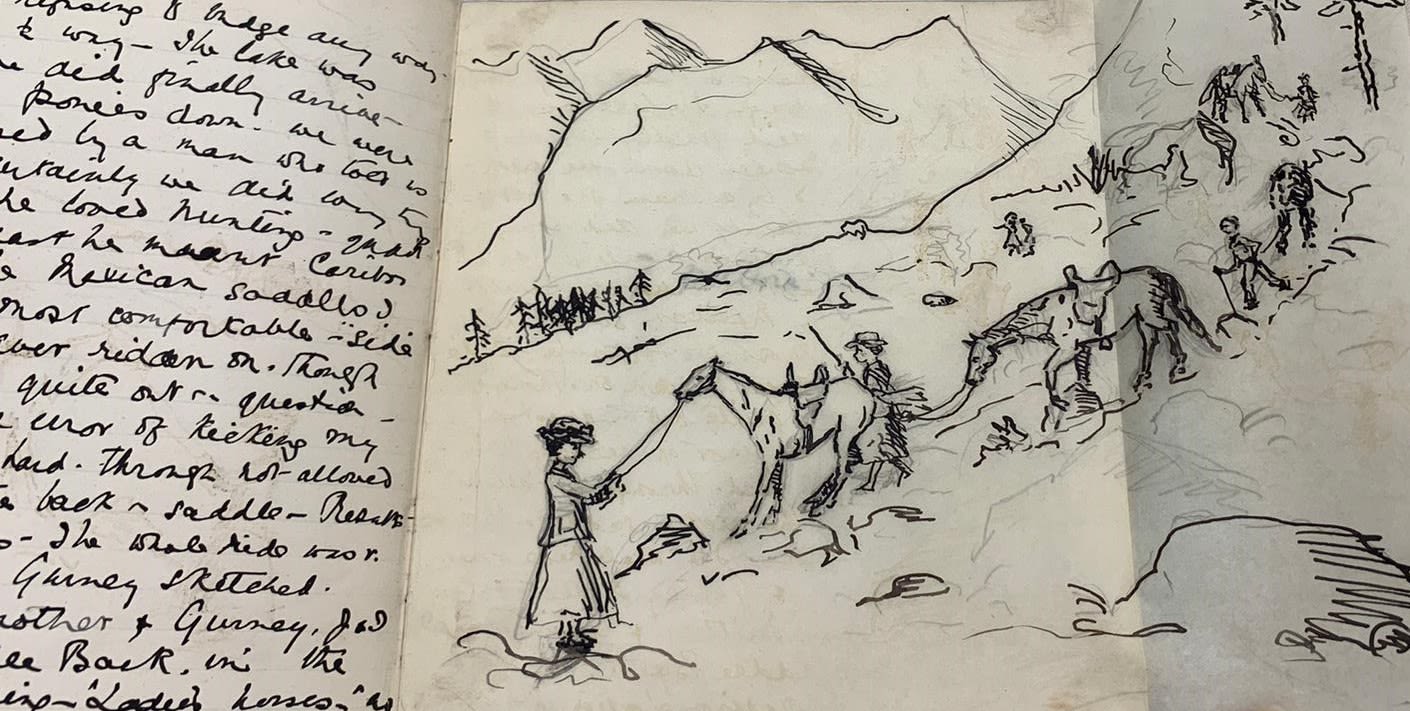
1. Don't
be led astray
Many authors commented on the risk of travellers being exposed to foreign cultures and losing their sense of national identity. According to Howell, a traveller needs to be well-educated in the ways and history of his own country and to behave appropriately as ‘The eyes of all the world are upon him’.
James Howell, Instructions and directions for forren travel. London: Printed by W.W. for Humphrey Moseley, at the Princes Arms, in St. Pauls Church-yard, 1650. Cosin S.6.28
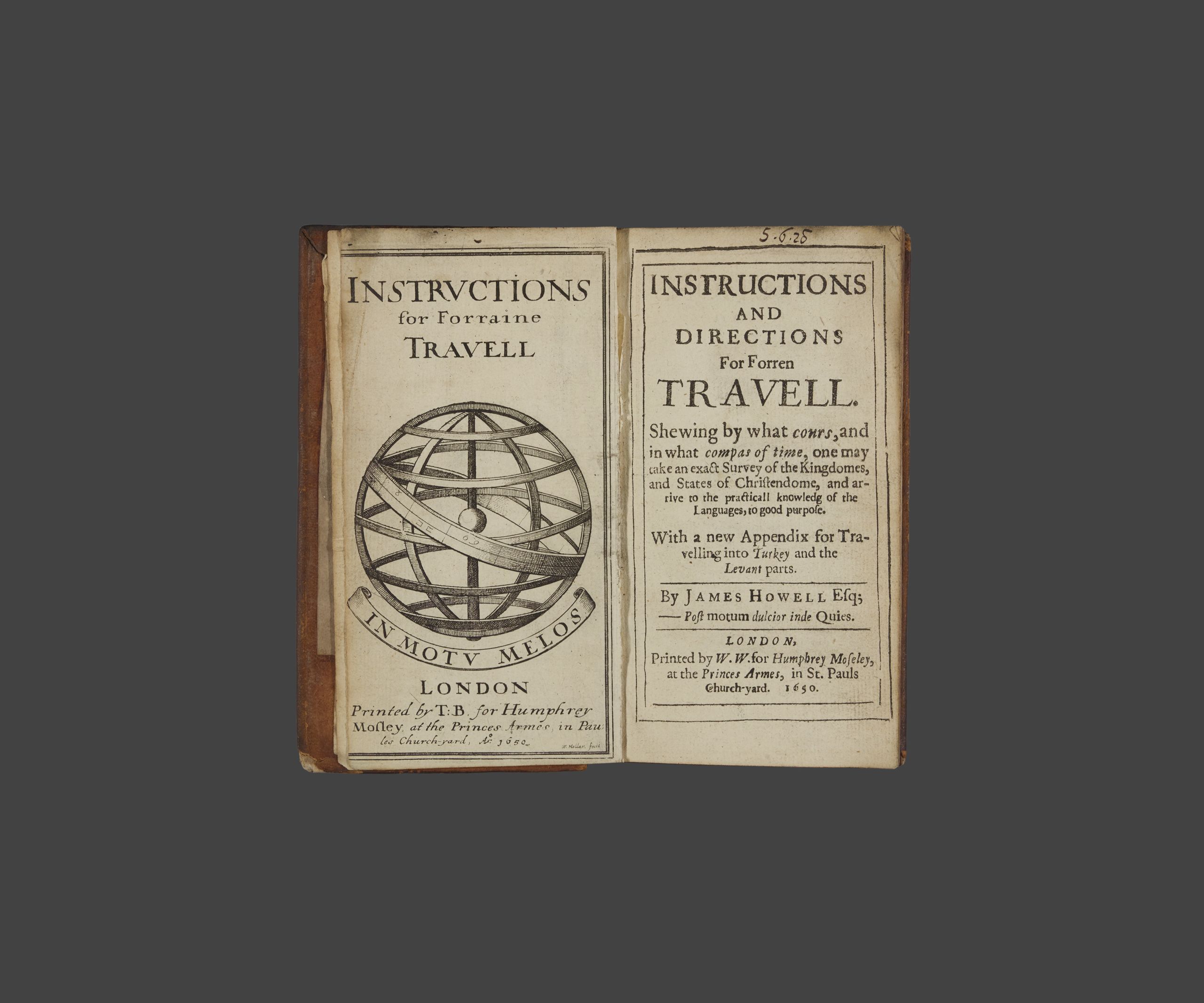
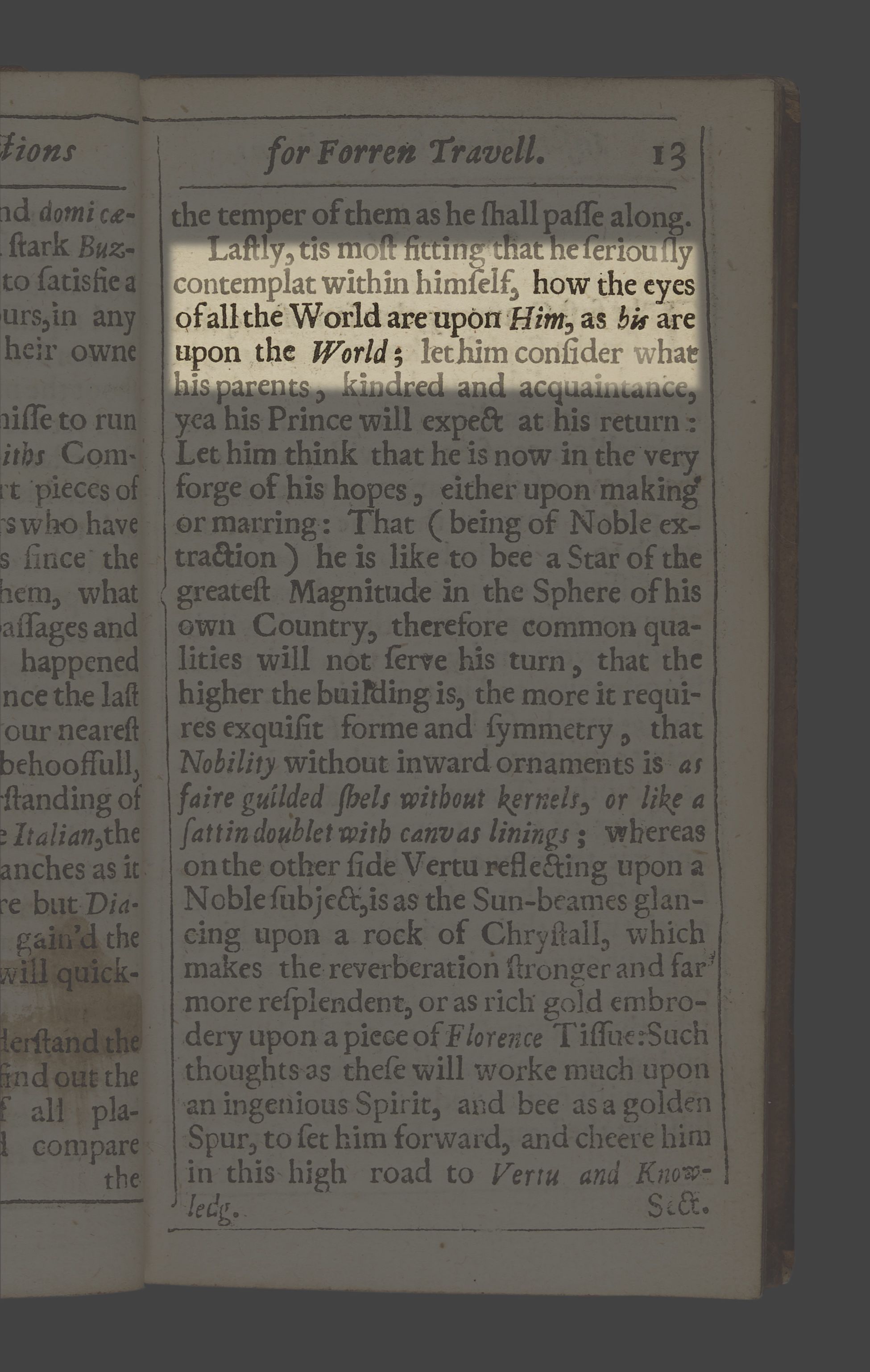
2. Don't
stand out from the crowd
By contrast, Moryson advises travellers to take on the customs and manners of the places they visit or even pretend to be from a different country. This could gain travellers access to places that were otherwise off-limits and help them avoid being robbed or ripped off.
Moryson sums this up by quoting the phrase: "Being at Rome, the Roman manners use, And otherwhere, each places custome chuse".
Fynes Moryson, An itinerary written by Fynes Moryson Gent. First in the Latine tongue, and then translated by him into English… [At London] : [printed by John Beal[e]], dwelling in Aldersgate stree[t]], [1617]. Routh 60.C.8
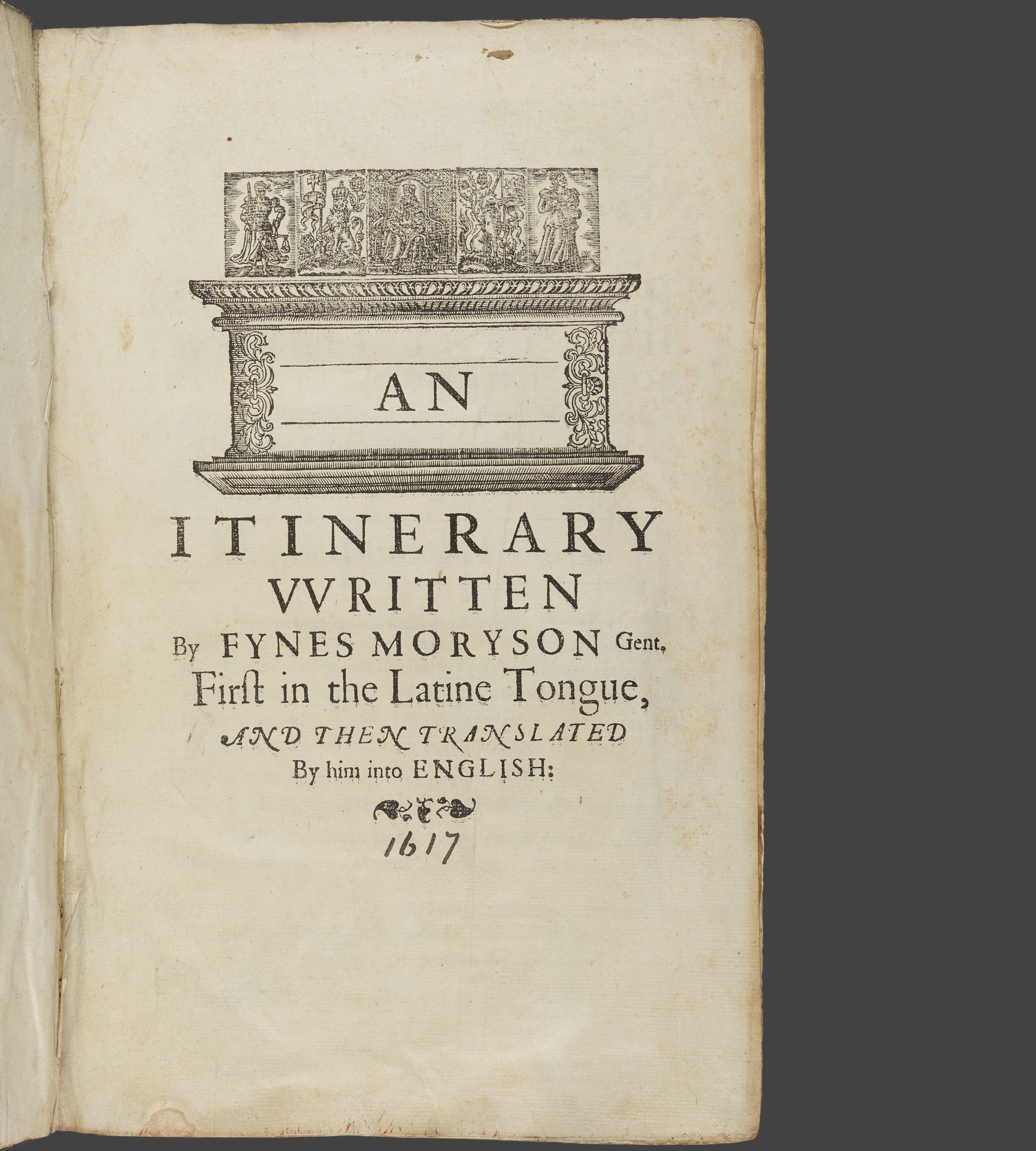
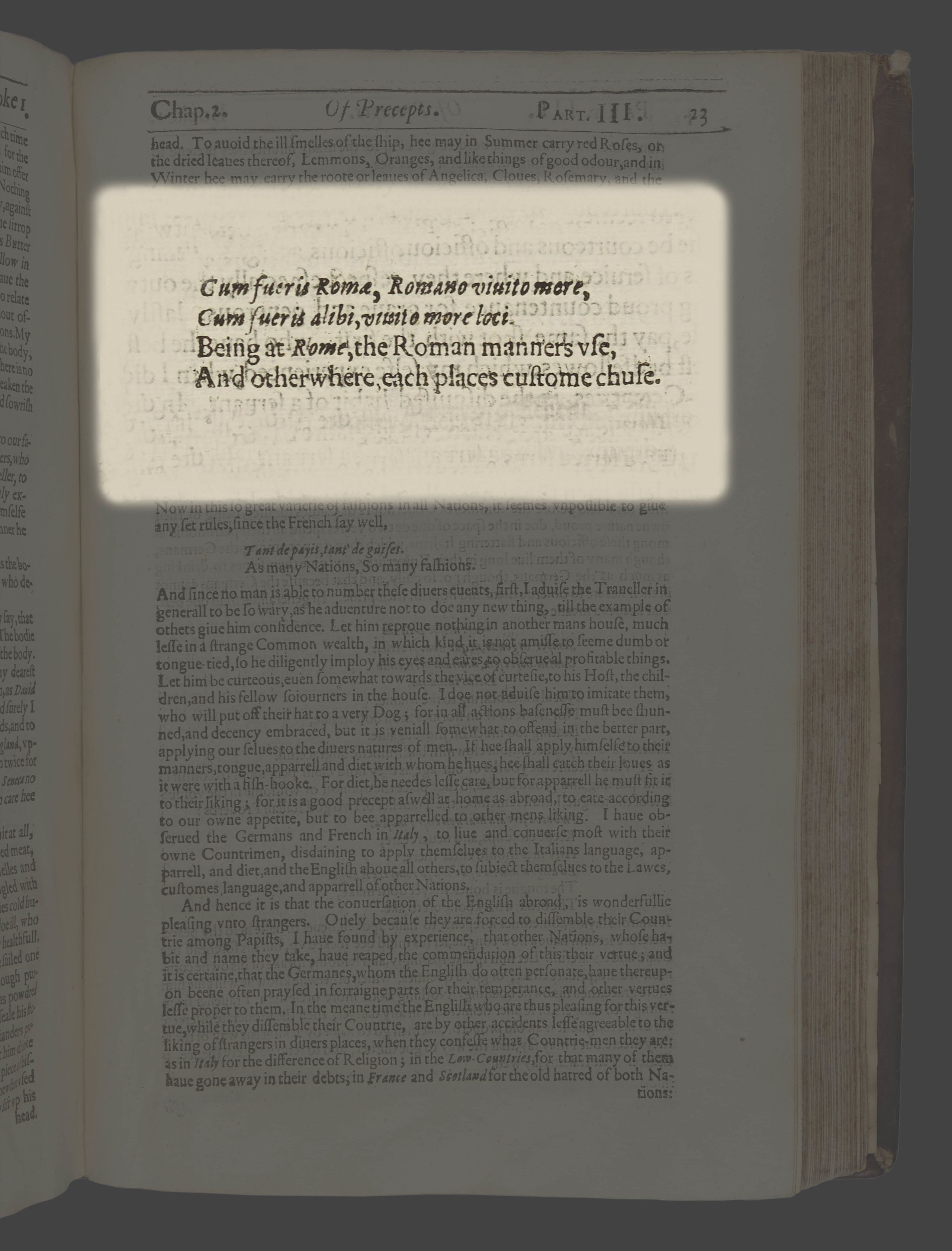
3. Don't
overpack
Many travellers write a packing list, though not many are likely to pack as thoroughly as this early 20th century essayist. The 102 items on the list demonstrate that voyaging from home did not mean a break from the formalities expected of the British upper class.
On a practical level, modern technology has simplified travel for many, removing the need for some of these items; though even in the age of the smartphone, packing a corkscrew is a good tip to remember.
E.V. Lucas, "Have I Left Anything Out?"
(c. 1920s). Add.MS.887/1/27
Love this item? Click here to download it as a postcard to send to a friend.
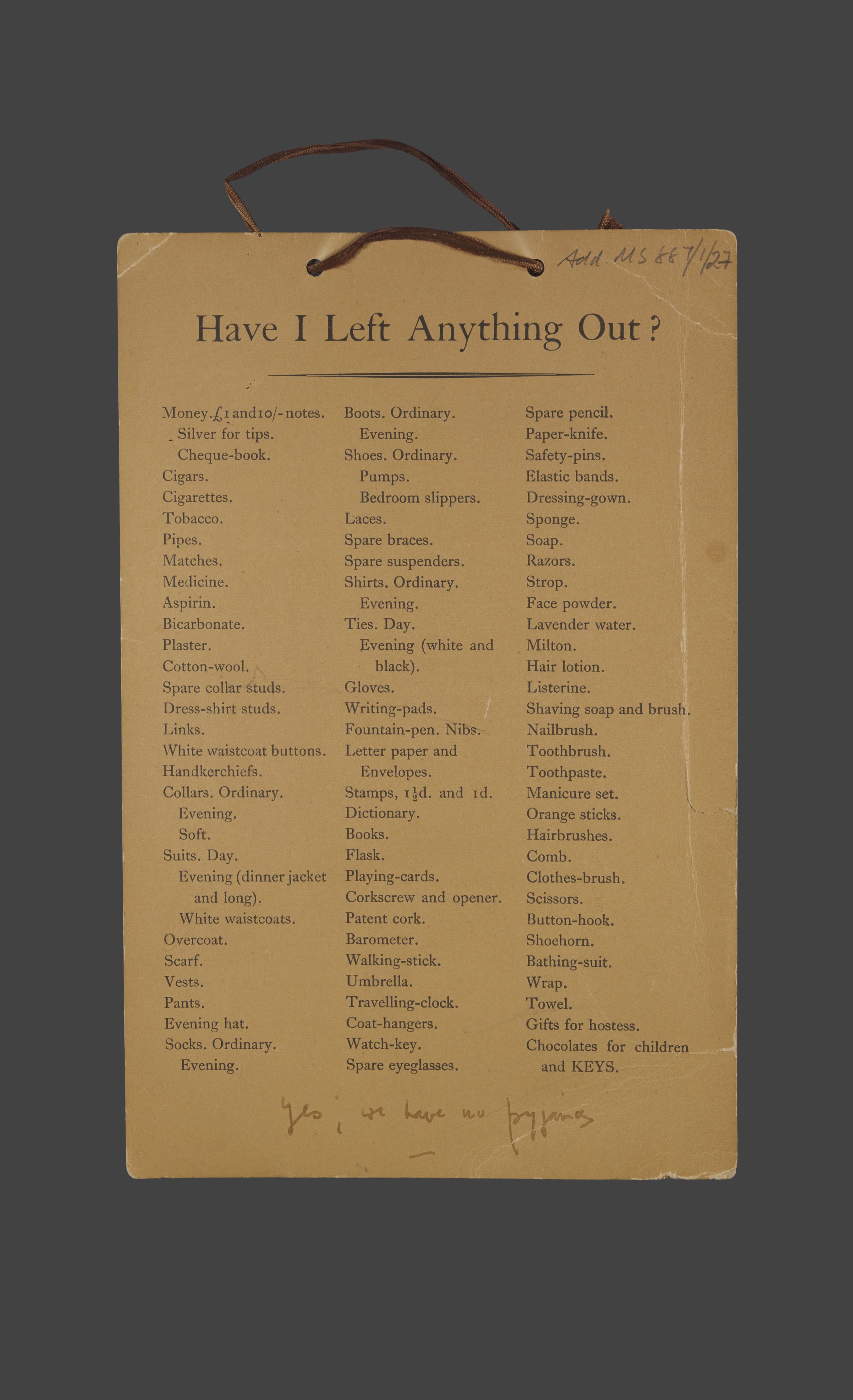
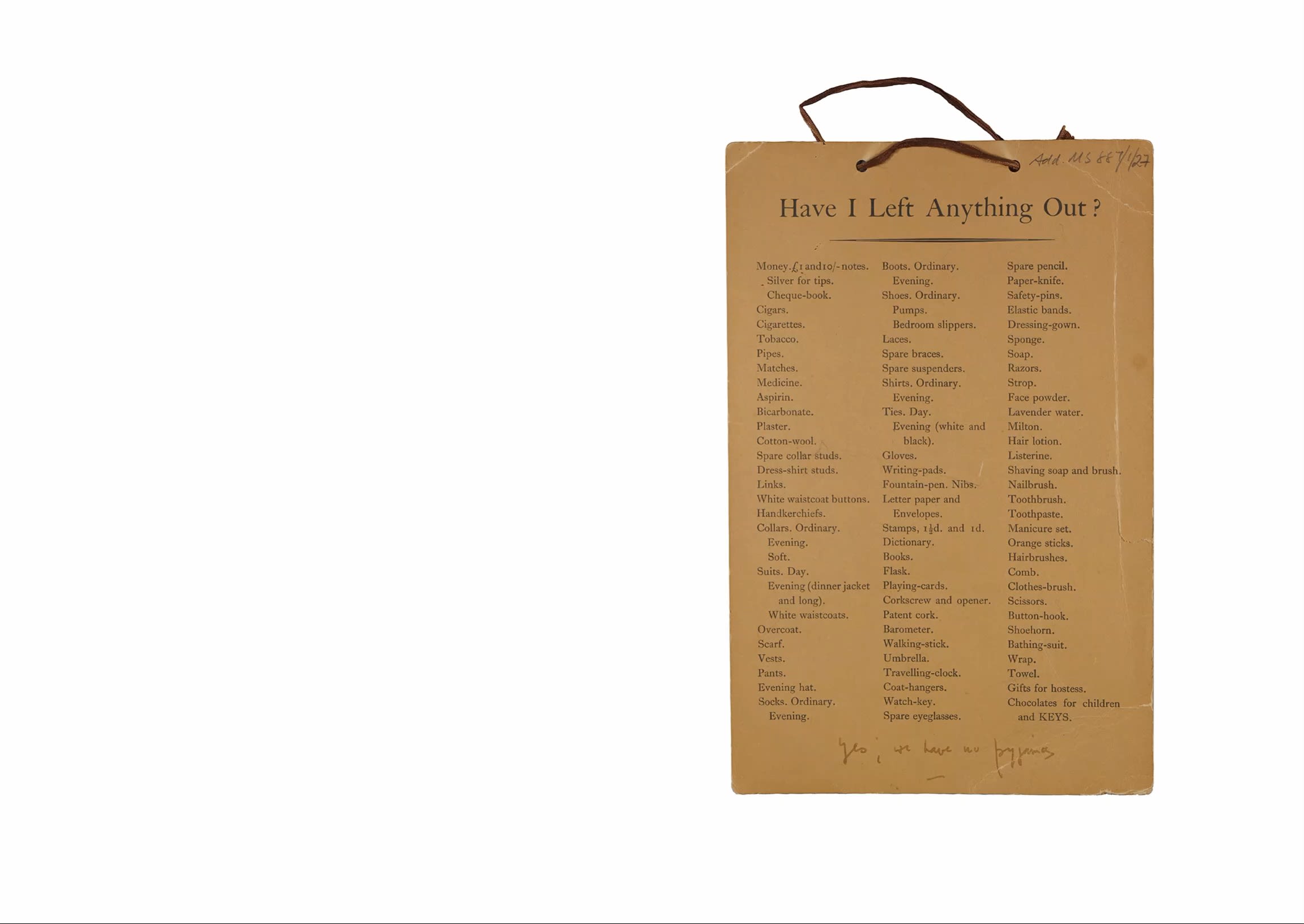
1. Do
learn the language
The English text of this phrasebook is credited to William Caxton, founder of England’s first printing press. The expressions included are suggestive of the needs of international travellers in this period, particularly focusing on the types of people that traders may meet.
Not many people outside the British Isles spoke English, so it was important that travellers learnt at least the basics of any language used in the country they were visiting.
Vocabularius. French and English. [Westminster]: [Printed by William Caxton], [1480]. Bamburgh Select 83
Reproduced by permission of the Lord Crewe Trustees
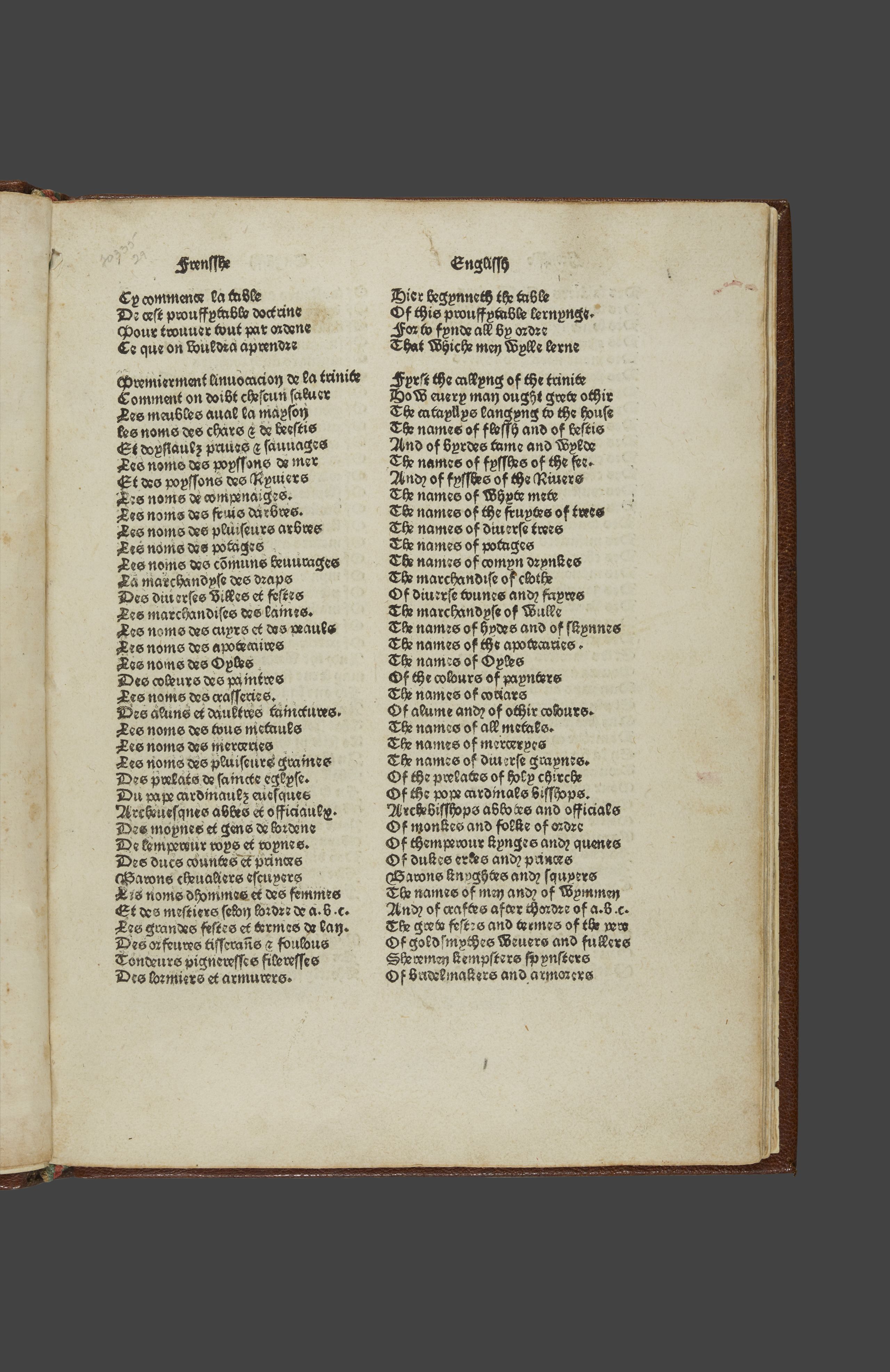
2. Do
remember your passport
We meet Mr. Yorick again in this novelisation of Sterne’s own travels through Europe in the 1760s. In one scene, Yorick lives the ultimate nightmare of every traveller by forgetting his passport.
Because the two countries were officially at war at the time of this novel, any Englishman in France would have required a passport or safe passage document granted by the French government. At his hotel in Paris, Yorick is threatened with imprisonment in the Bastille unless he acquires a passport.
The passports that we use today, issued by the state we are a citizen of, only became a legal necessity for travel abroad after 1918.
Laurence Sterne, A sentimental journey through France and Italy by Mr. Yorick. In two books. Göttingen: Printed by I.C. Dietrich, 1787. SC 08231
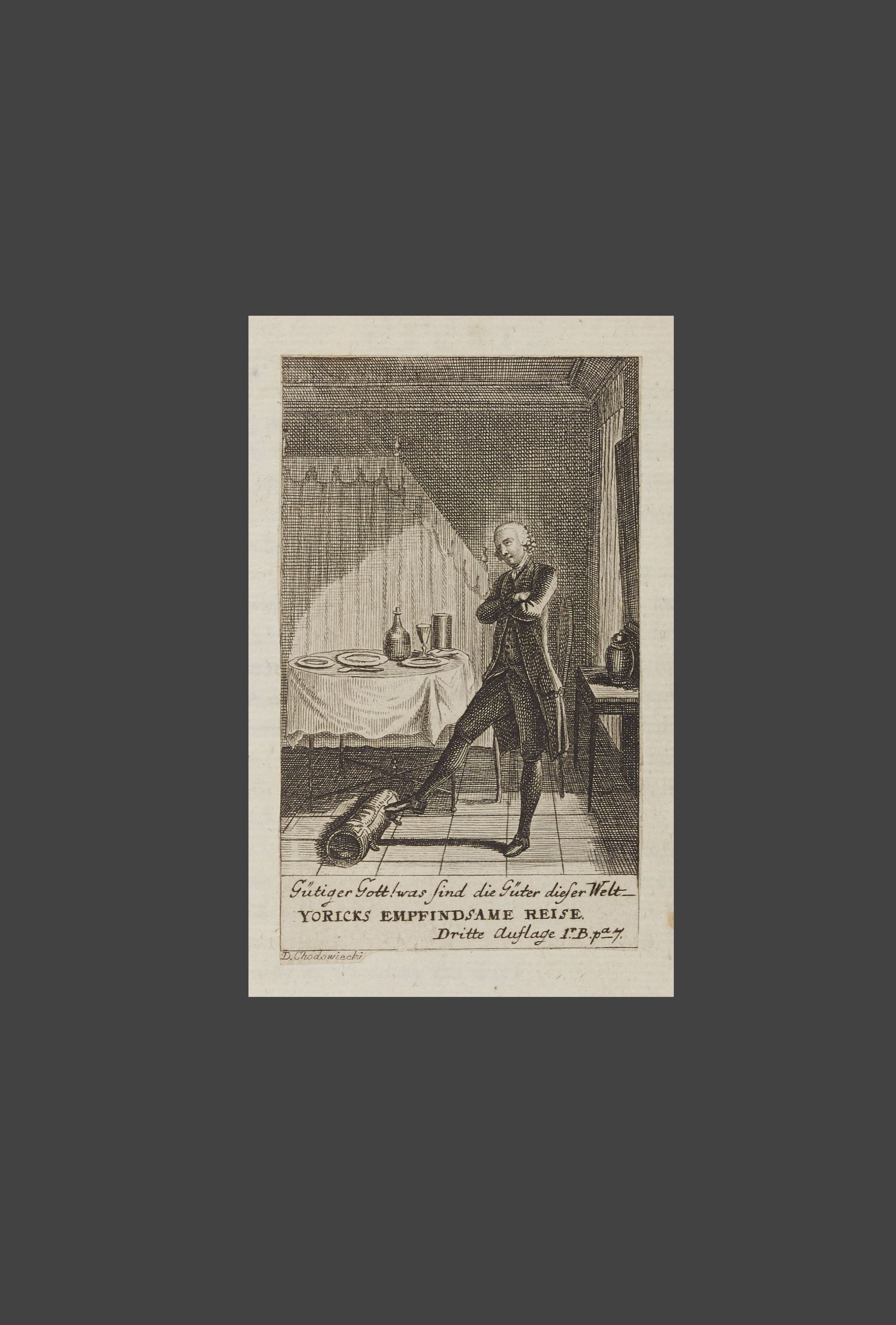
3. Do
consult
a guidebook
The style of guidebook we are familiar with today originated in the 1830s with books published by John Murray and Karl Baedeker. Before then travel guides were much less standardised, usually taking the form of personal accounts.
Heavily influenced by the expectations of readers, who demanded weird, wonderful and exotic detail just as much as facts and practical information, these pre-19th century works often revealed much about the writers themselves, as well as the places they described.
At best, these earliest guides show attempts to accept and understand cultural differences; at worst, they reveal intolerance, racism and xenophobia.
These examples demonstrate both the development of Paris as a city and the changing style and content of guidebooks from the 1600s onwards.
The accounts of Brice and Le Rouge, written before the Revolution of 1789, focus on their personal reflections of the city, while the Baedeker and Murray guides are much more objective.
Murray’s guidebooks introduced numbered maps suggesting routes to follow, while Baedeker had a star system to highlight key sites to visit. Two stars meant it was unmissable.
This style of guidebook went hand in hand with foreign travel becoming more accessible to people in the 1800s, partly due to new and improved forms of transport.
Click the images below to view in full-screen.
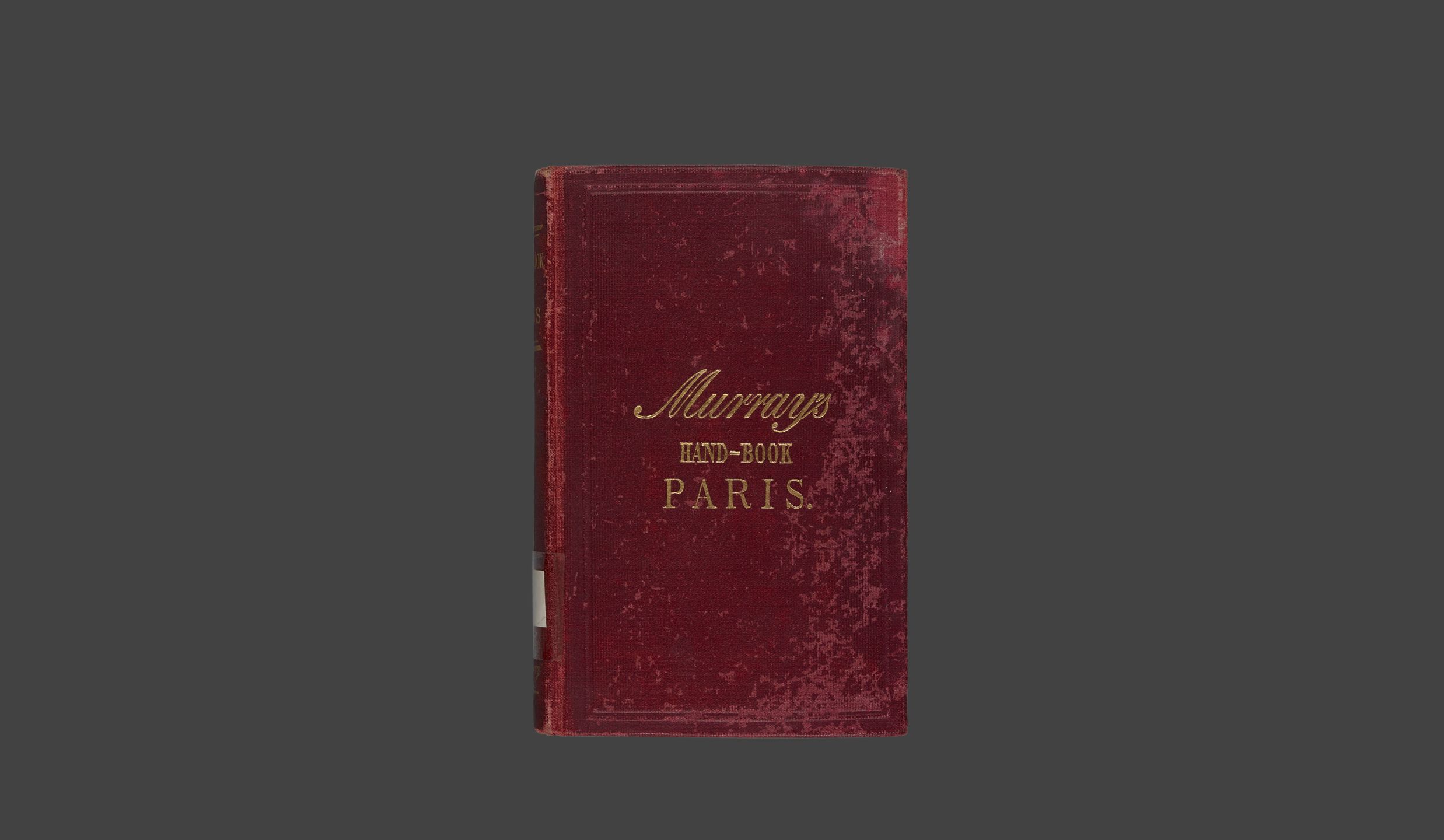
1. Don’t Be Led Astray
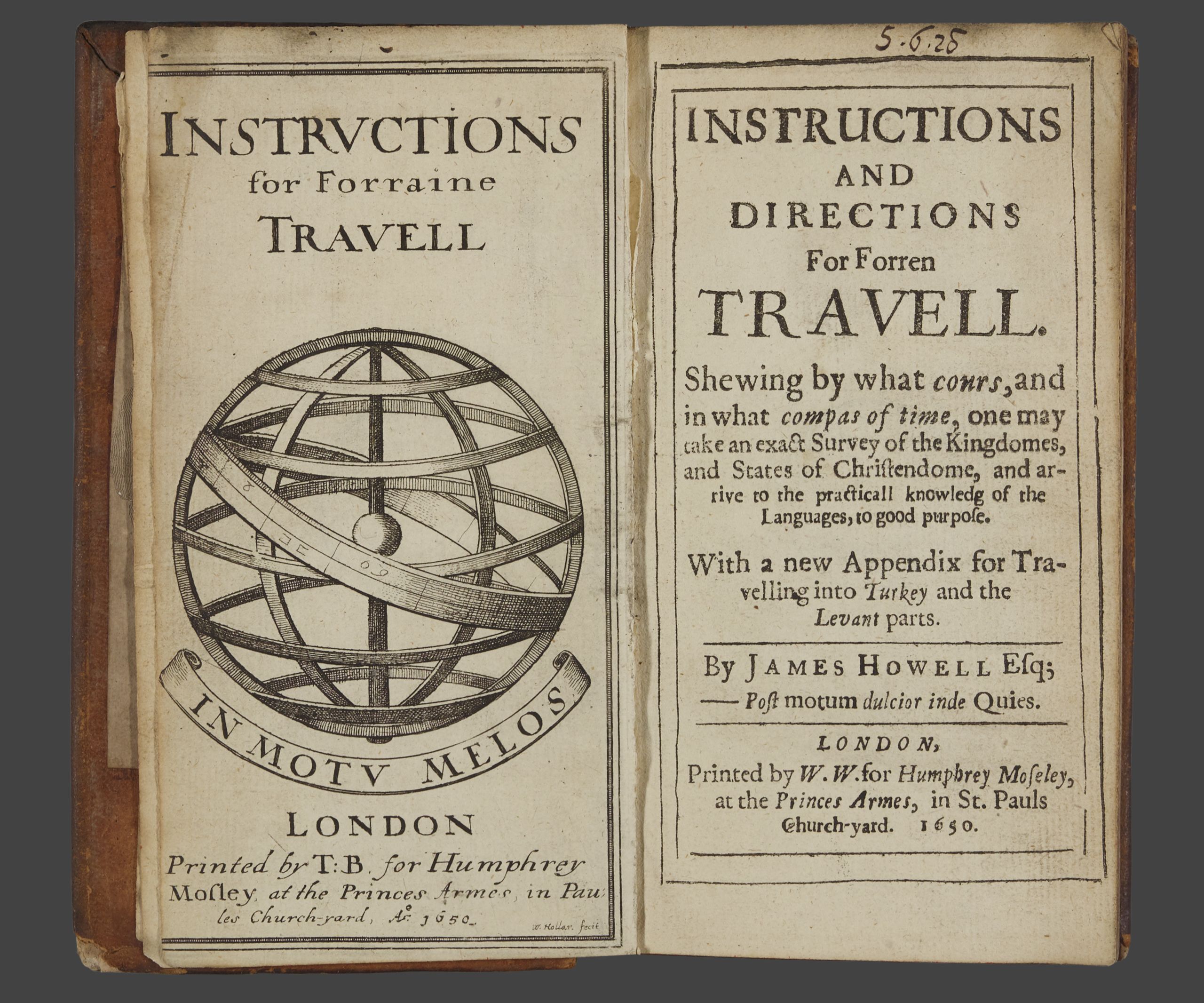
Many authors commented on the risk of travellers being exposed to foreign cultures and losing their sense of national identity. According to Howell, a traveller needs to be well-educated in the ways and history of his own country and to behave appropriately as ‘The eyes of all the world are upon him’.
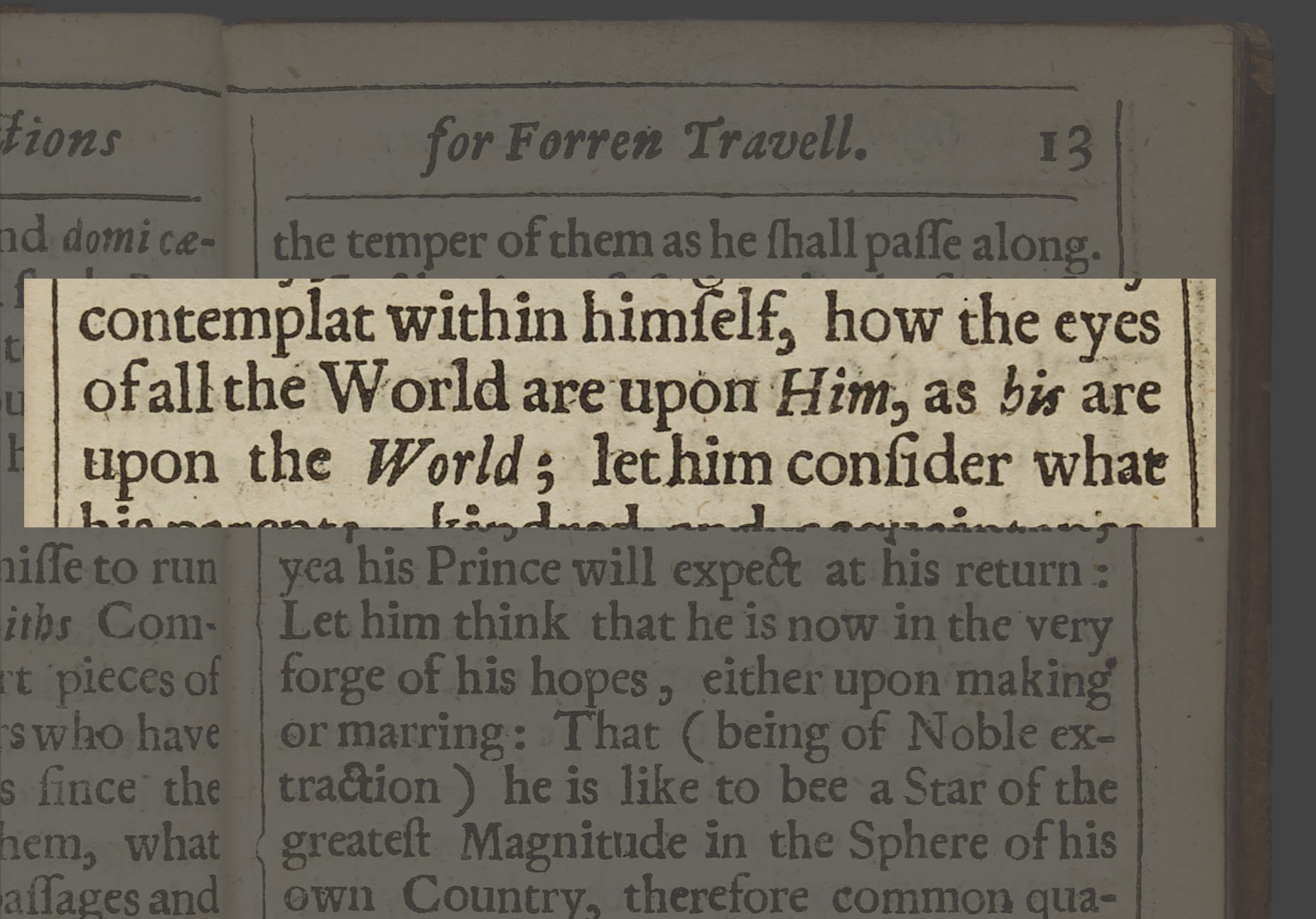
James Howell, Instructions and directions for forren travel. London: Printed by W.W. for Humphrey Moseley, at the Princes Arms, in St. Pauls Church-yard, 1650. Cosin S.6.28
2. Don’t Stand Out From the Crowd
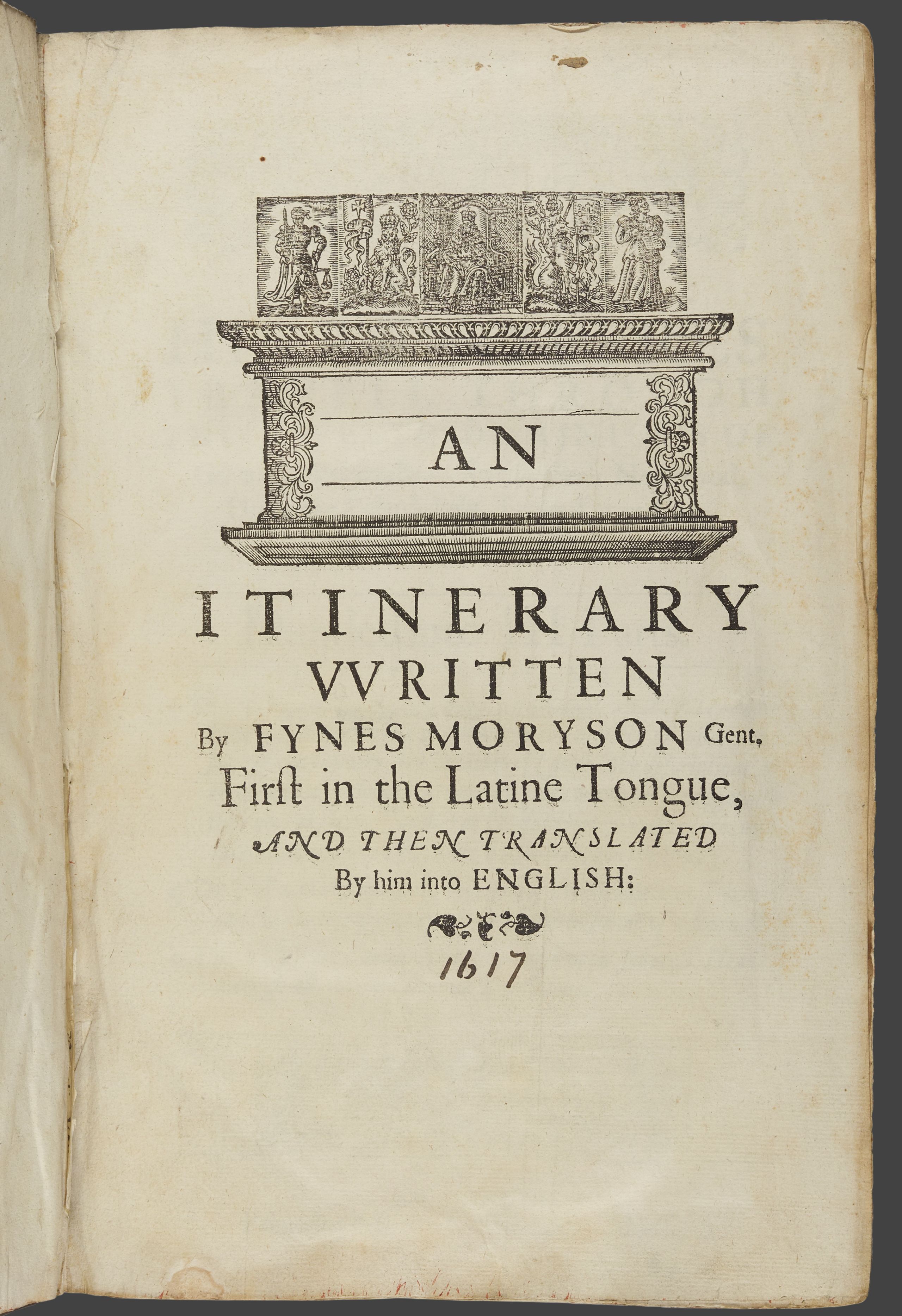
By contrast, Moryson advises travellers to take on the customs and manners of the places they visit or even pretend to be from a different country. This could gain travellers access to places that were otherwise off-limits and help them avoid being robbed or ripped off.
Moryson sums this up by quoting the phrase: "Being at Rome, the Roman manners use, And otherwhere, each places custome chuse".
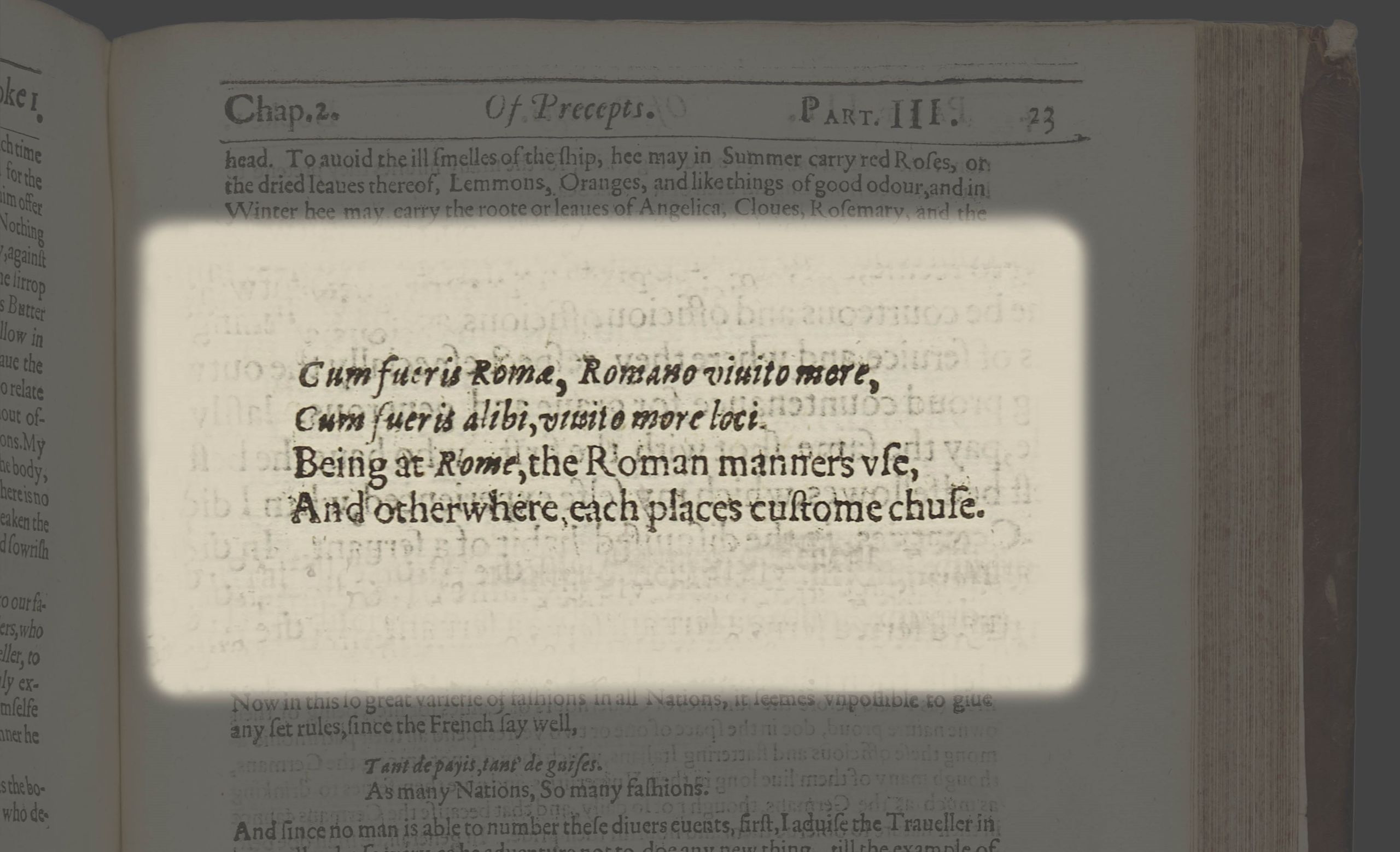
Fynes Moryson, An itinerary written by Fynes Moryson Gent. First in the Latine tongue, and then translated by him into English … [At London] : [printed by John Beal[e]], dwelling in Aldersgate stree[t]], [1617]. Routh 60.C.8
3. Don’t Overpack
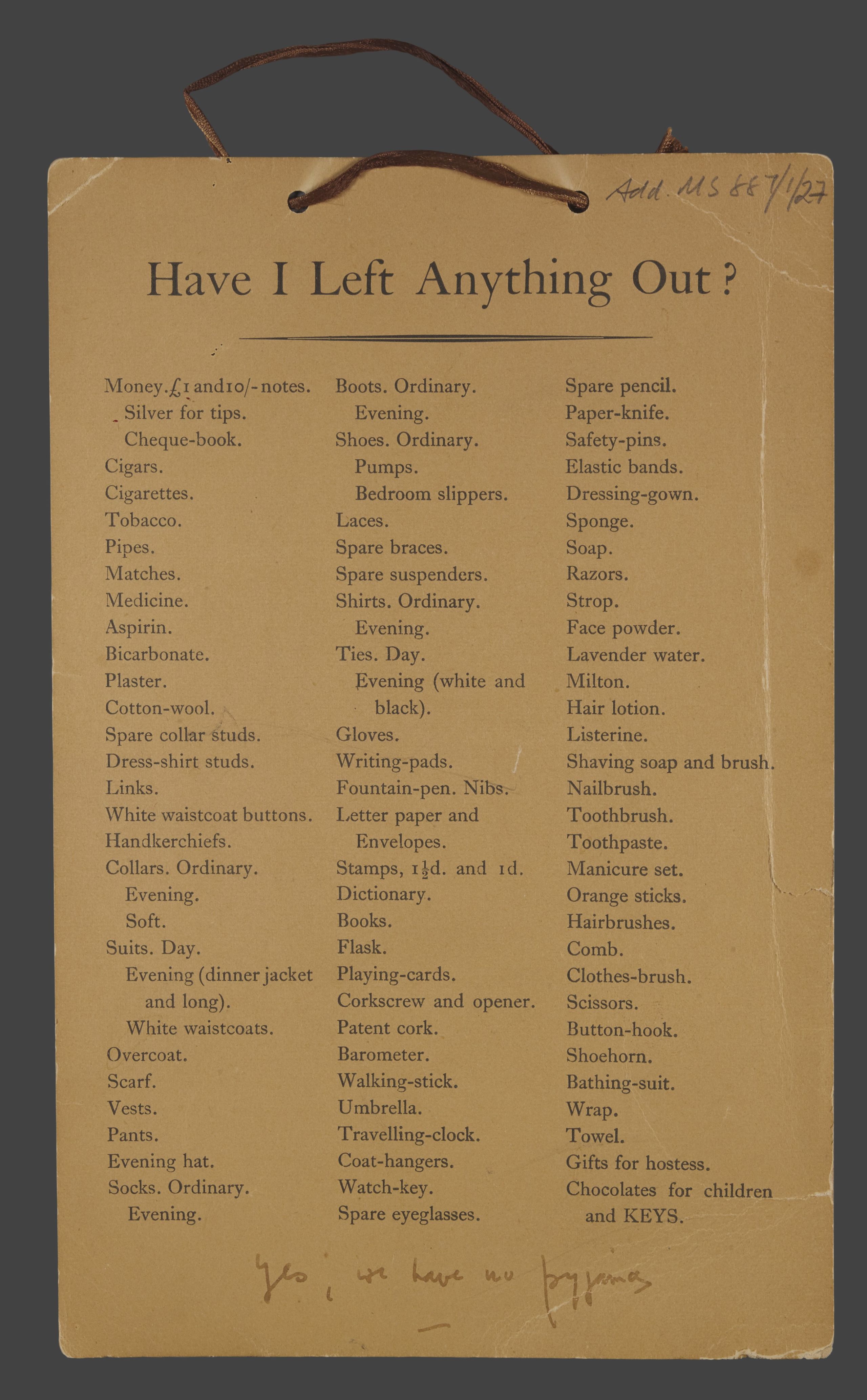
Many travellers write a packing list, though not many are likely to pack as thoroughly as this early 20th century essayist. The 102 items on the list demonstrate that voyaging from home did not mean a break from the formalities expected of the British upper class.
On a practical level, modern technology has simplified travel for many, removing the need for some of these items; though even in the age of the smartphone, packing a corkscrew is a good tip to remember.
E.V. Lucas, "Have I Left Anything Out?" (c. 1920s). Add.MS.887/1/27
Love this item? Download it as a postcard to send to a friend.
1. Do Learn the Language
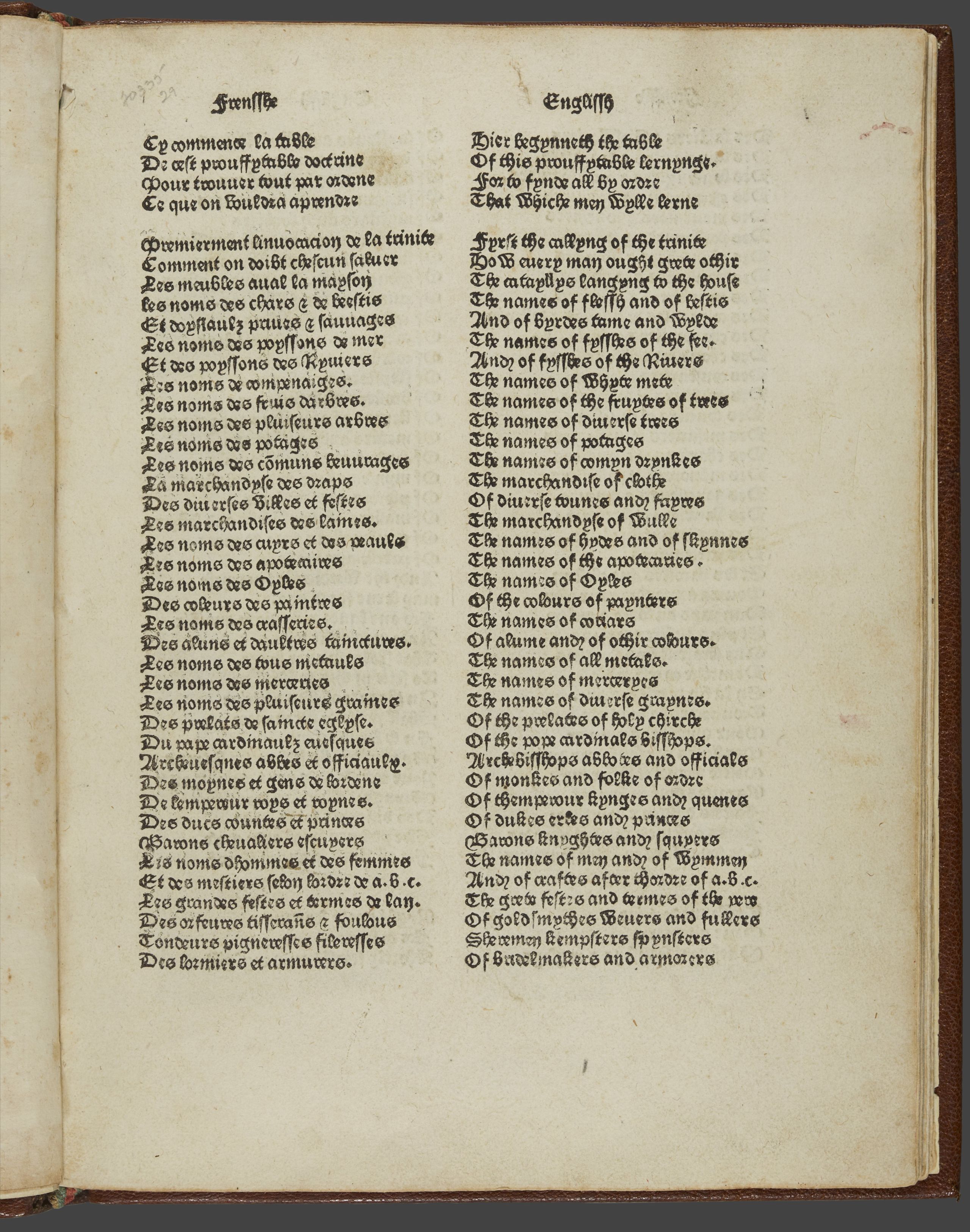
The English text of this phrasebook is credited to William Caxton, founder of England’s first printing press. The expressions included are suggestive of the needs of international travellers in this period, particularly focusing on the types of people that traders may meet.
Not many people outside the British Isles spoke English, so it was important that travellers learnt at least the basics of any language used in the country they were visiting.
Vocabularius. French and English. [Westminster]: [Printed by William Caxton], [1480]. Bamburgh Select 83
Reproduced by permission of the Lord Crewe Trustees
2. Do Remember Your Passport
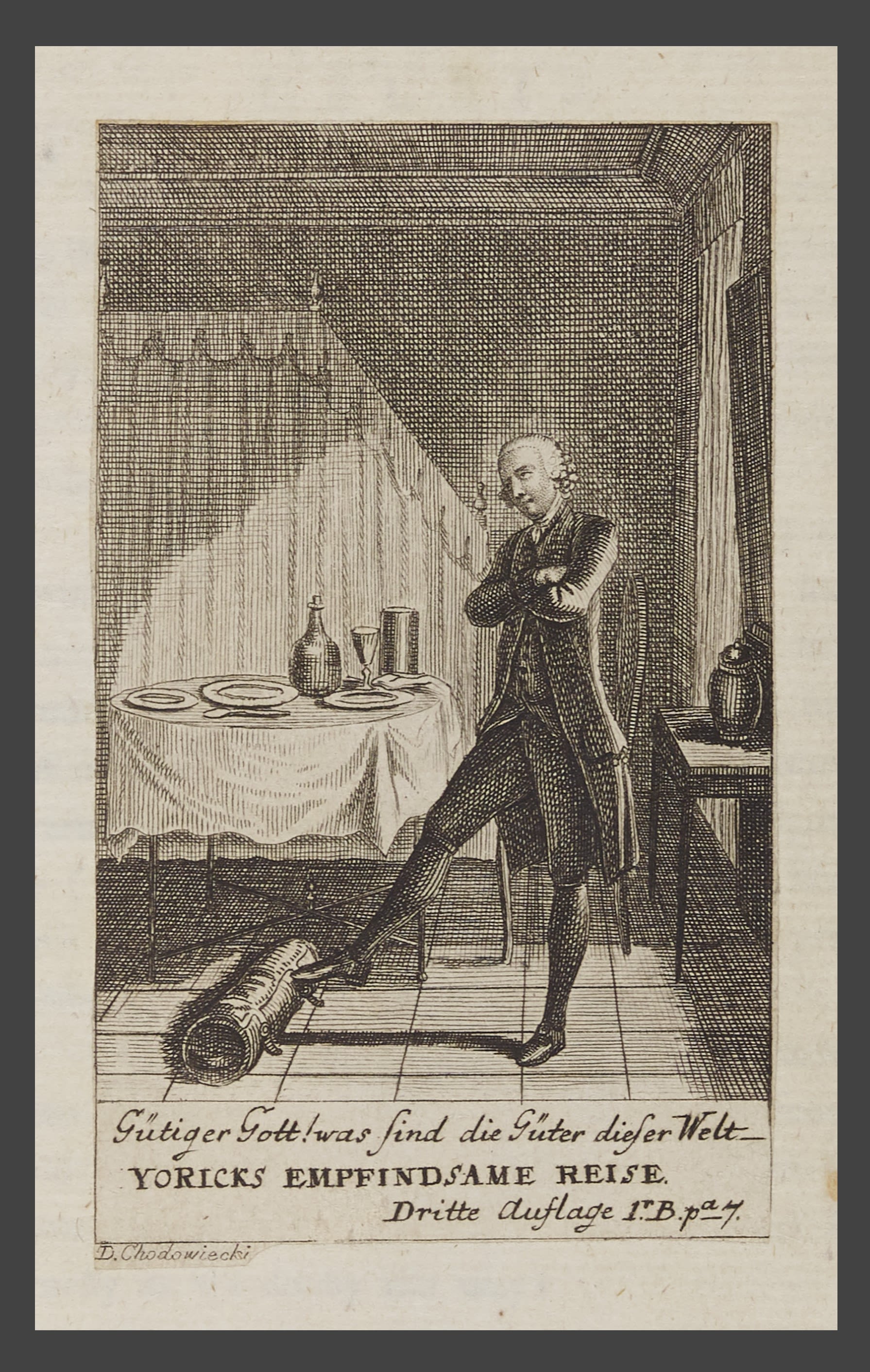
We meet Mr. Yorick again in this novelisation of Sterne’s own travels through Europe in the 1760s. In one scene, Yorick lives the ultimate nightmare of every traveller by forgetting his passport.
Because the two countries were officially at war at the time of this novel, any Englishman in France would have required a passport or safe passage document granted by the French government. At his hotel in Paris, Yorick is threatened with imprisonment in the Bastille unless he acquires a passport.
The passports that we use today, issued by the state we are a citizen of, only became a legal necessity for travel abroad after 1918.
Laurence Sterne, A sentimental journey through France and Italy by Mr. Yorick. In two books. Göttingen: Printed by I.C. Dietrich, 1787. SC 08231
3. Do Consult a Guidebook
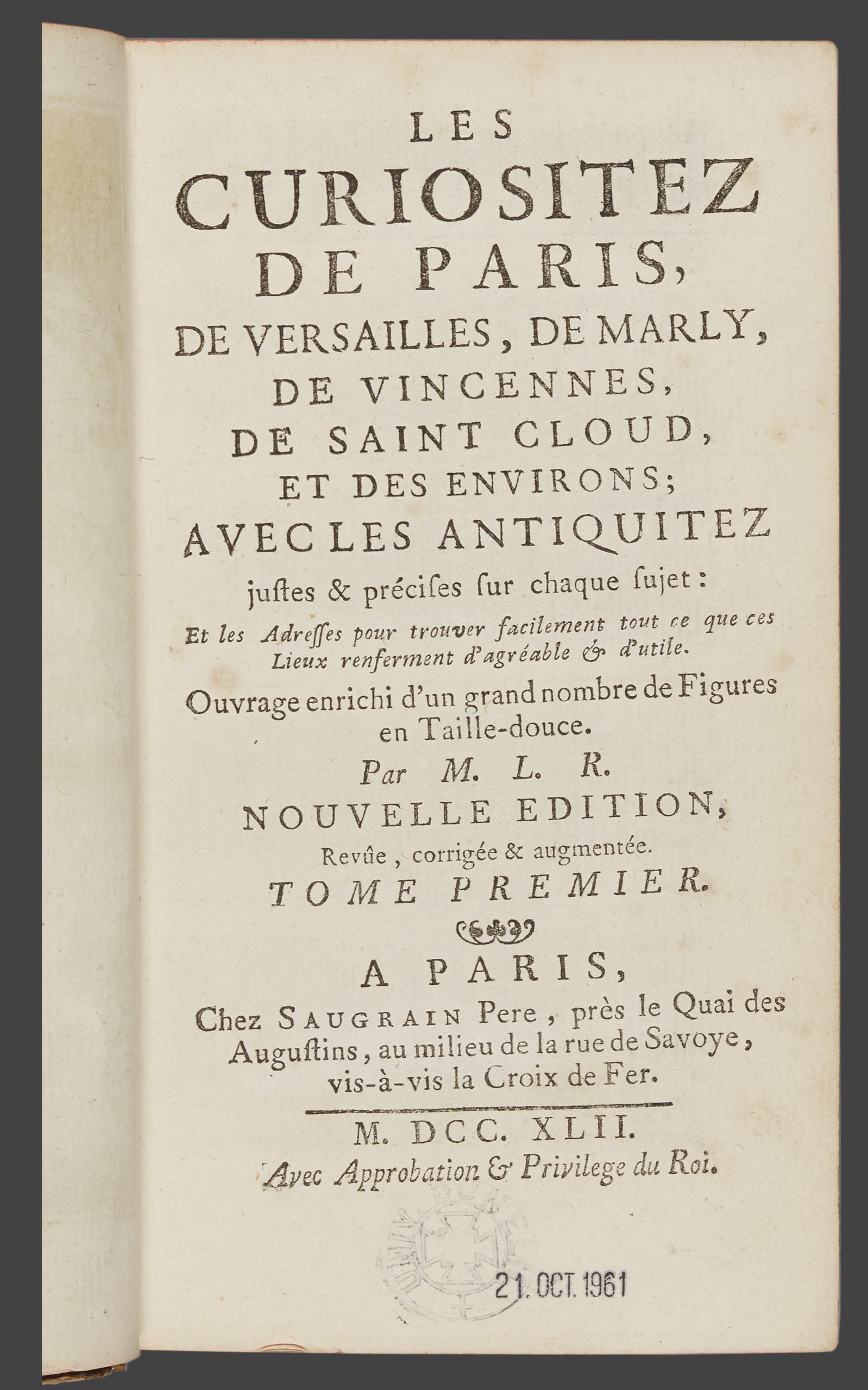
The style of guidebook we are familiar with today originated in the 1830s with books published by John Murray and Karl Baedeker. Before then travel guides were much less standardised, usually taking the form of personal accounts.
Heavily influenced by the expectations of readers, who demanded weird, wonderful and exotic detail just as much as facts and practical information, these pre-19th century works often revealed much about the writers themselves, as well as the places they described.
At best, these earliest guides show attempts to accept and understand cultural differences; at worst, they reveal intolerance, racism and xenophobia.
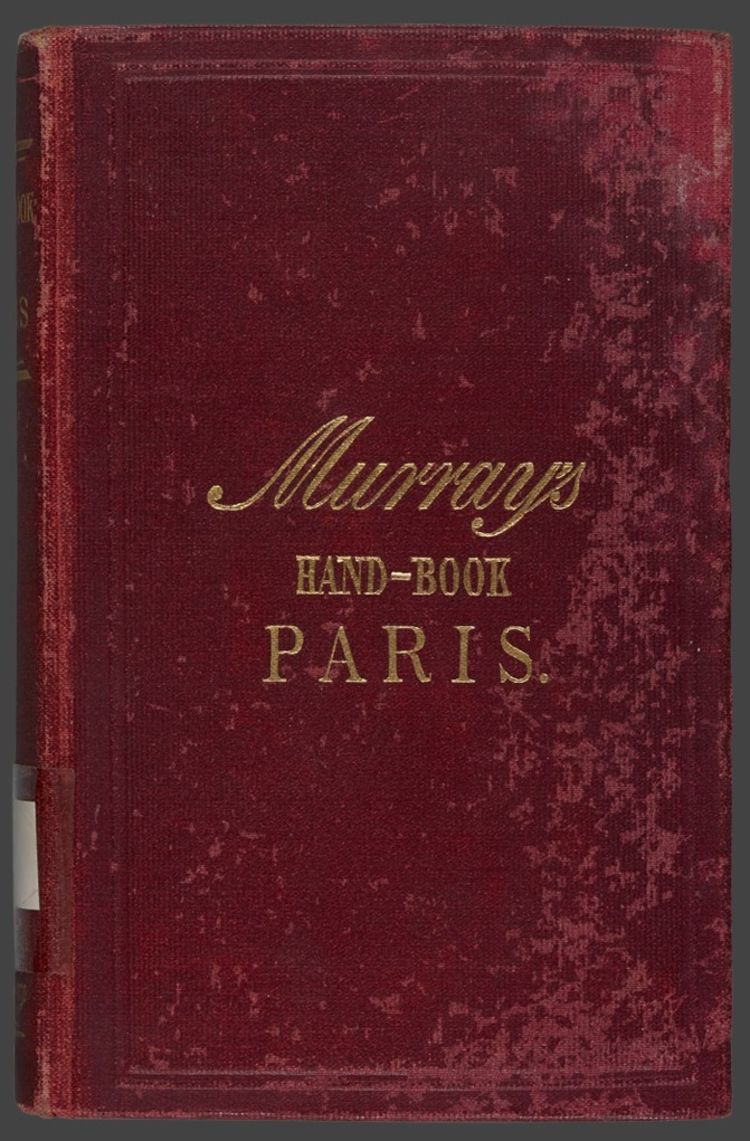
The examples shown here demonstrate both the development of Paris as a city and the changing style and content of guidebooks from the 1600s onwards. The accounts of Brice and Le Rouge, written before the Revolution of 1789, focus on their personal reflections of the city, while the Baedeker and Murray guides are much more objective.
Murray’s guidebooks introduced numbered maps suggesting routes to follow, while Baedeker had a star system to highlight key sites to visit. Two stars meant it was unmissable.
This style of guidebook went hand in hand with foreign travel becoming more accessible to people in the 1800s, partly due to new and improved forms of transport.
Tap the images below to view in full-screen.










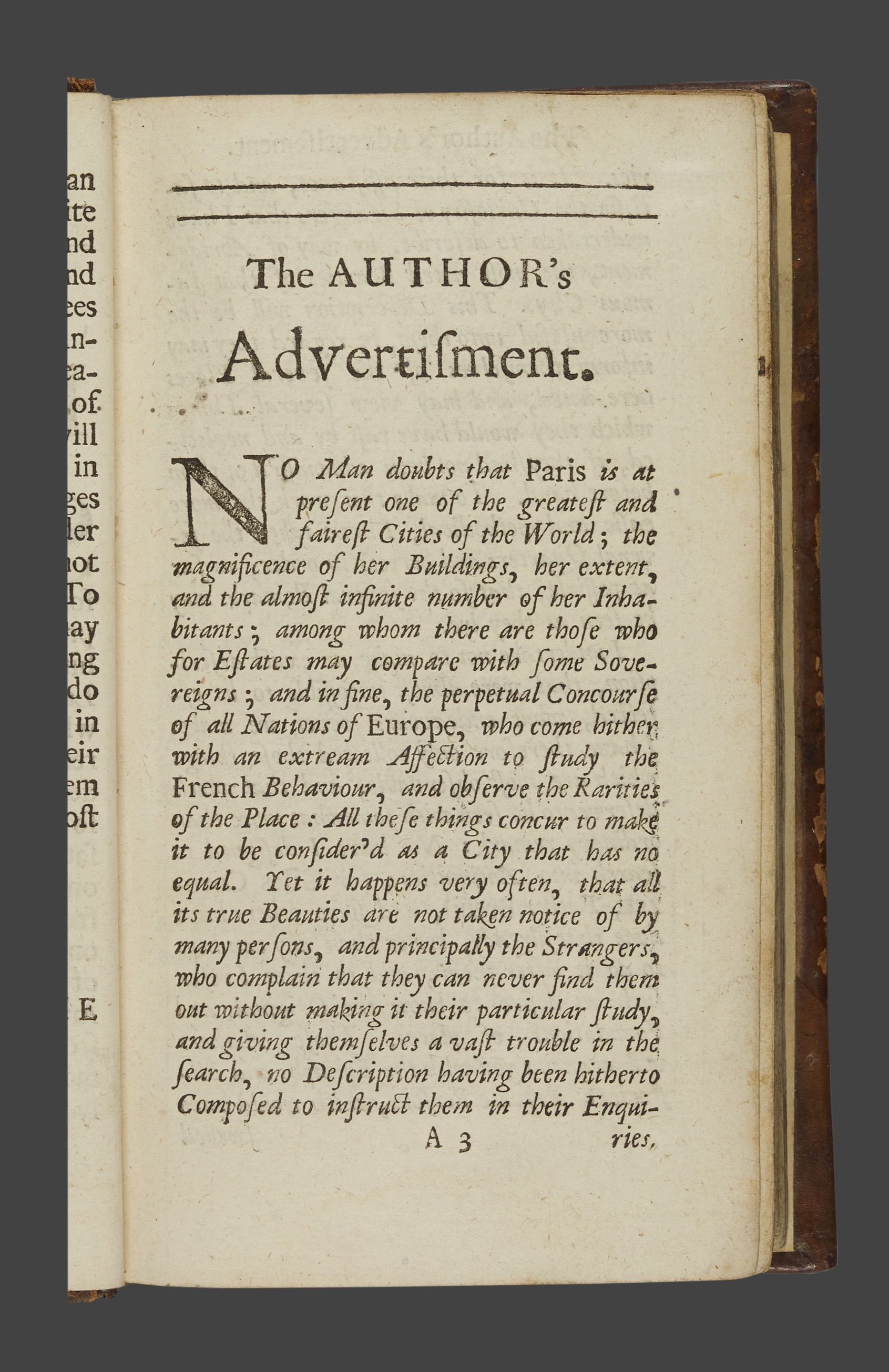
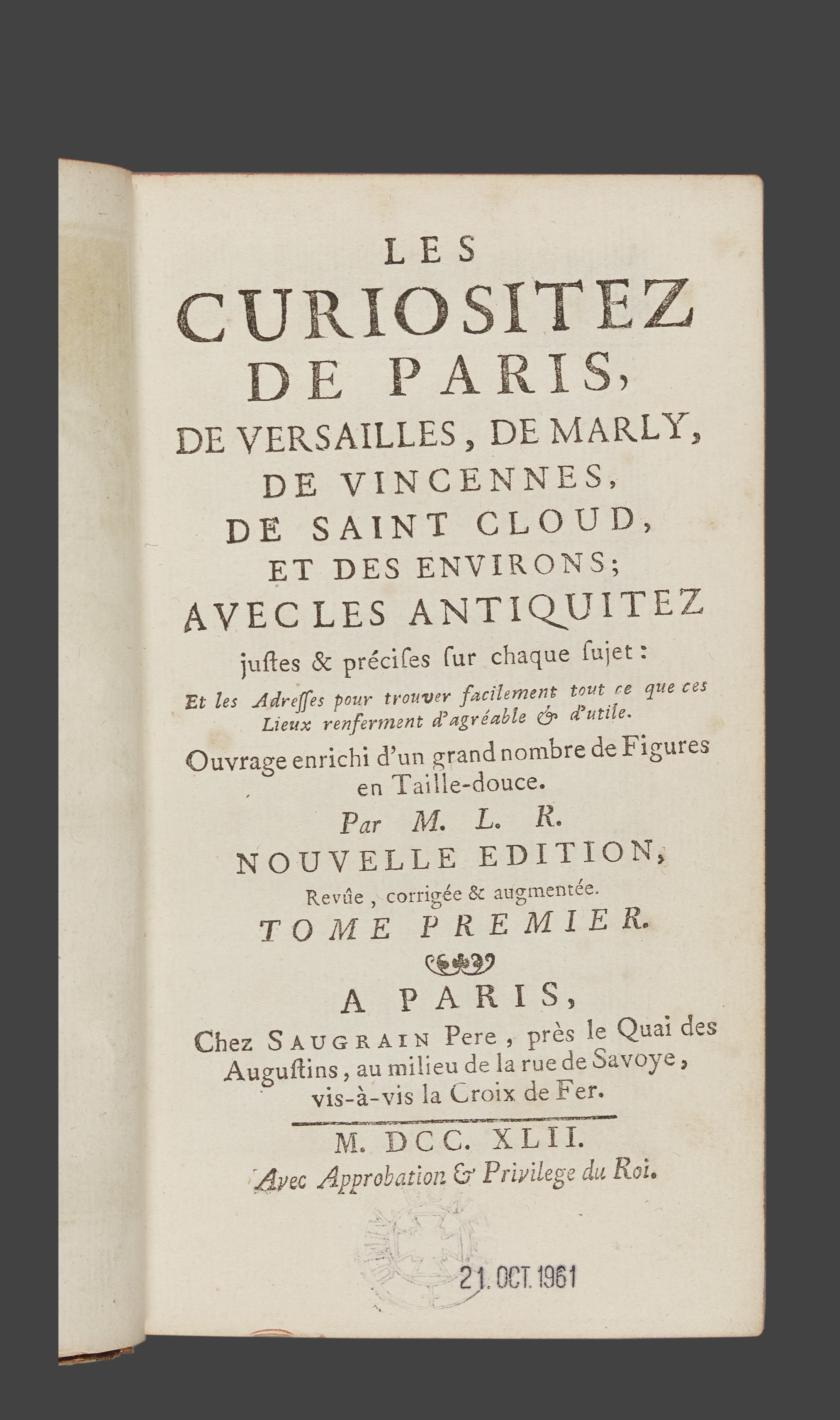
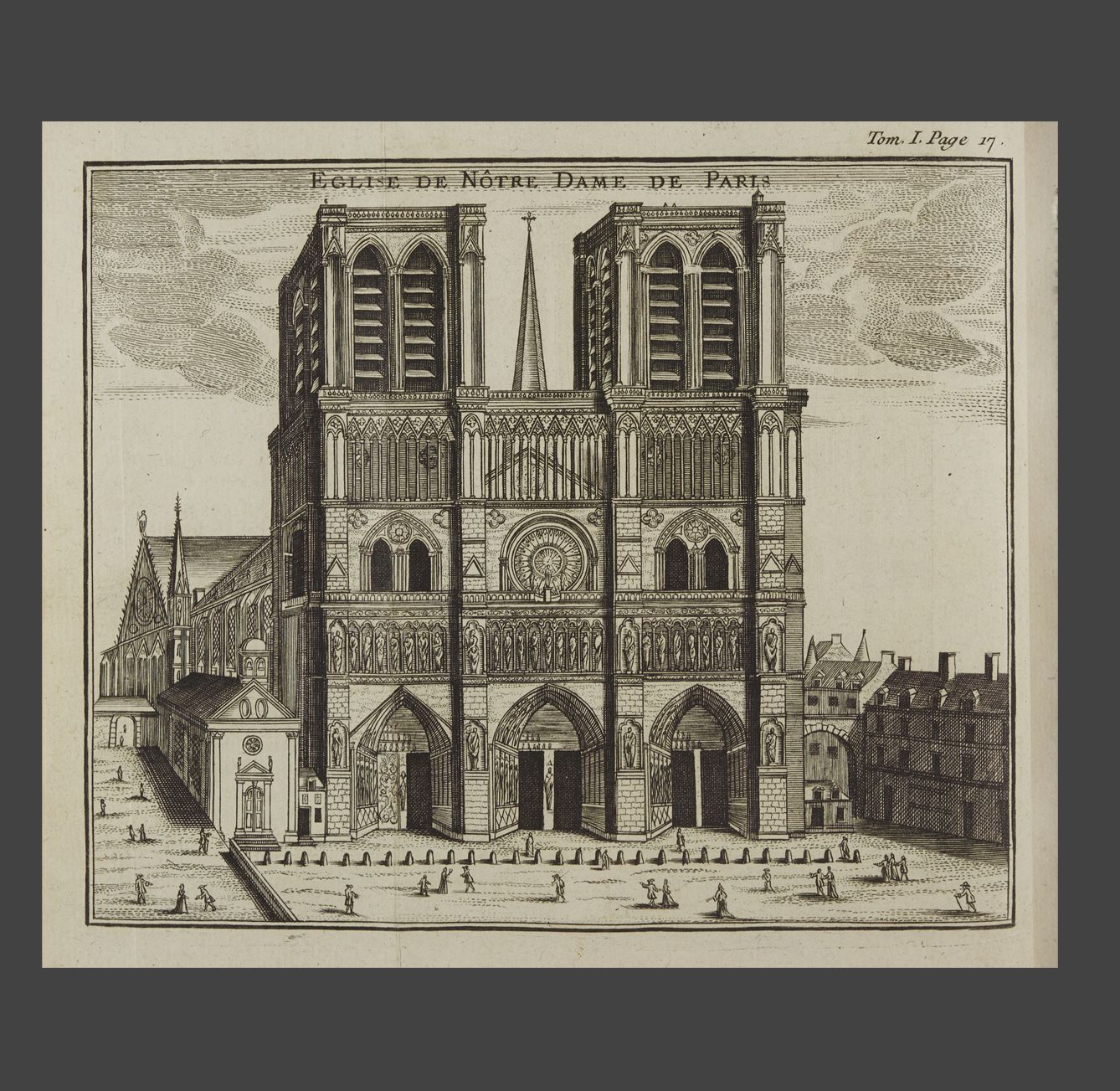
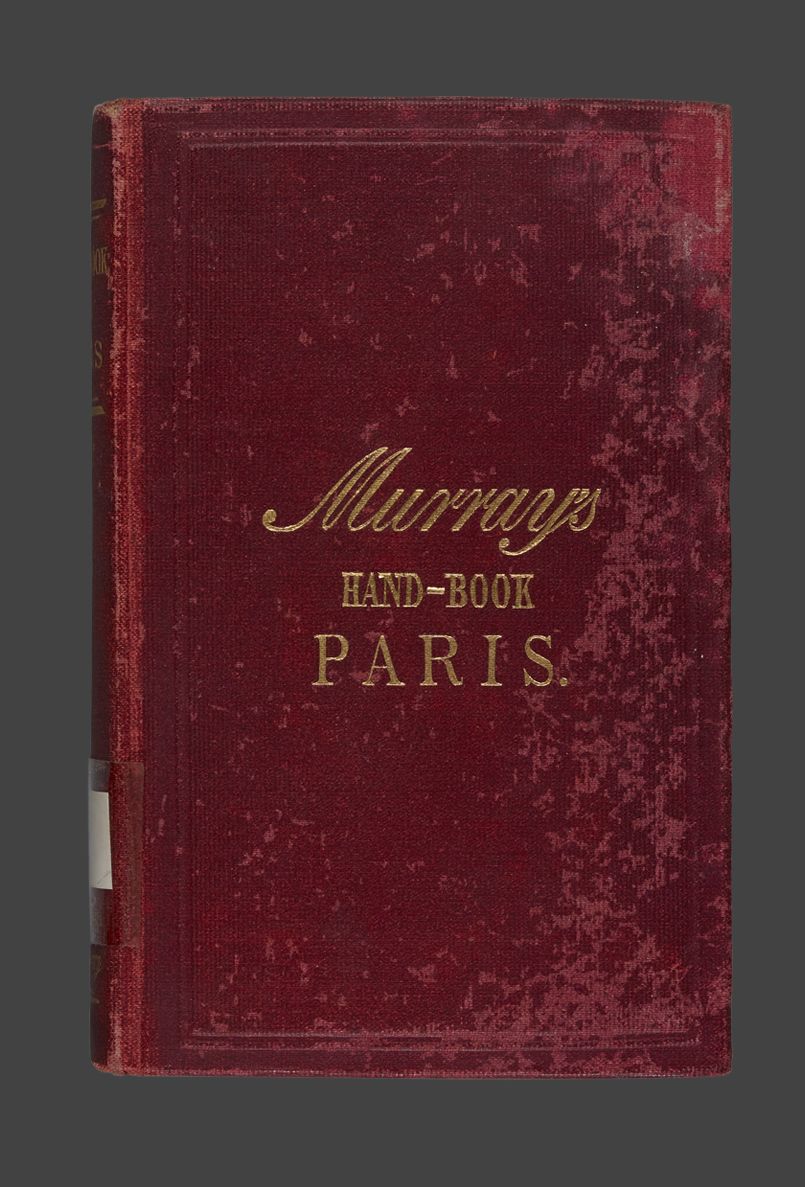
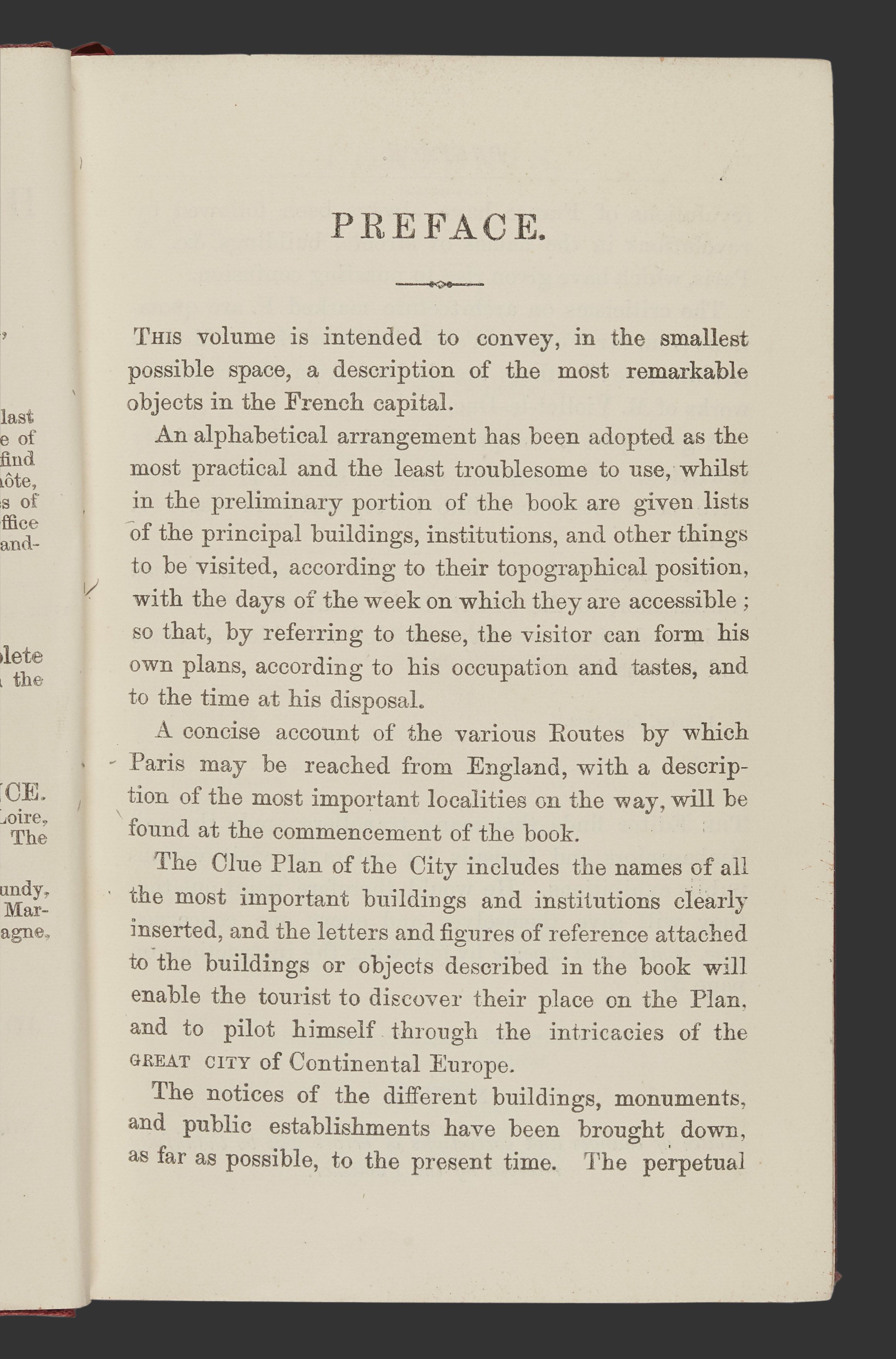
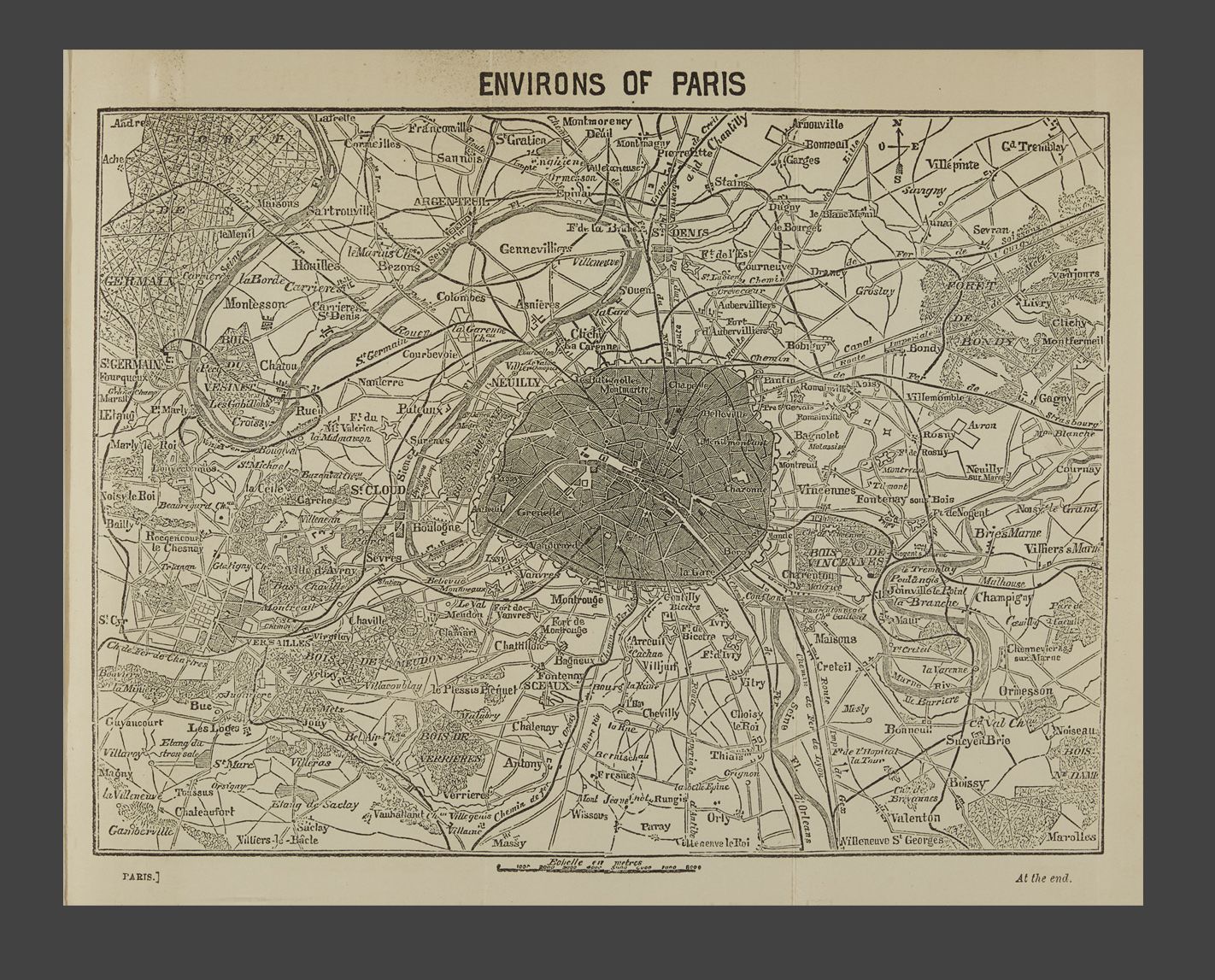
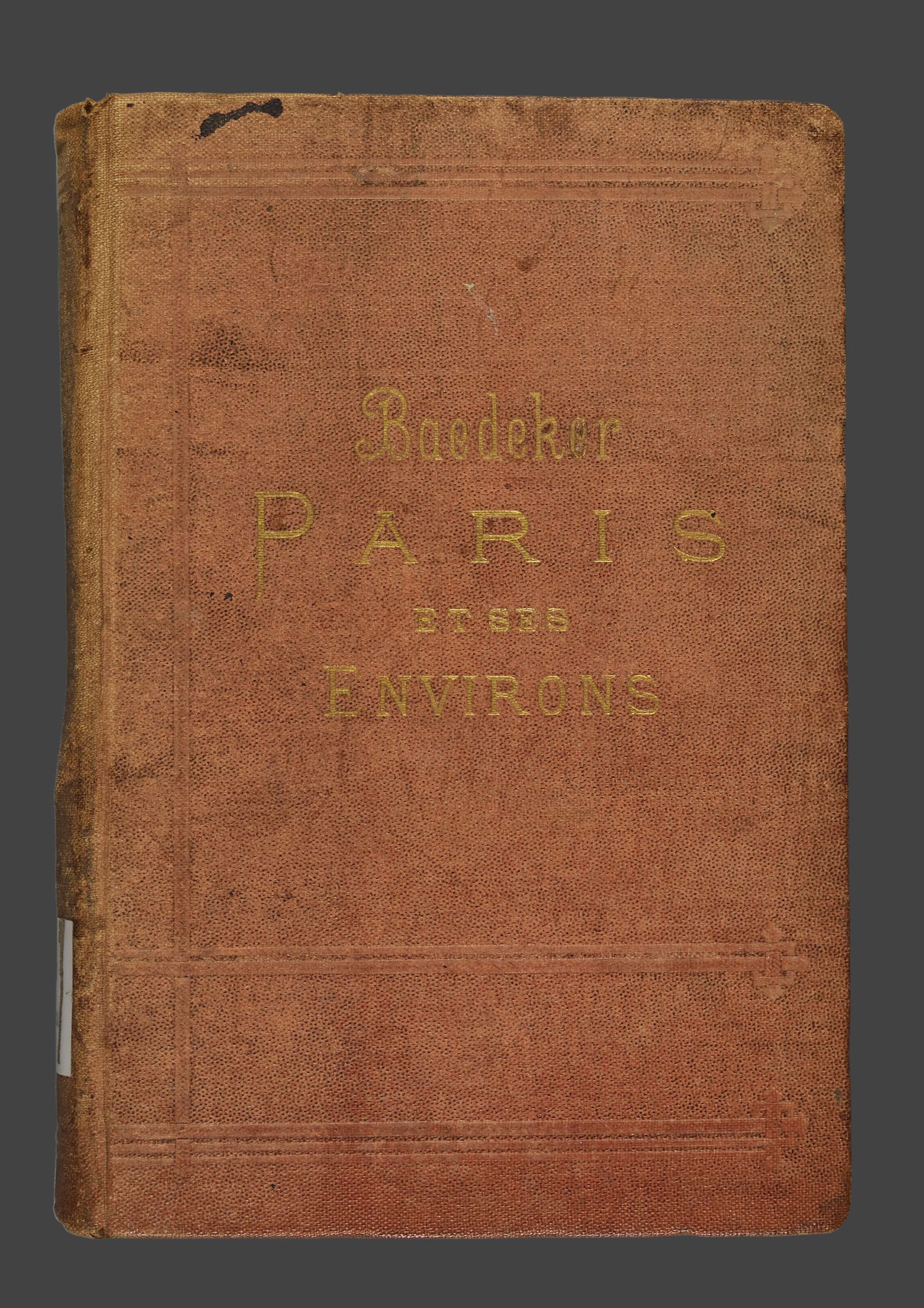
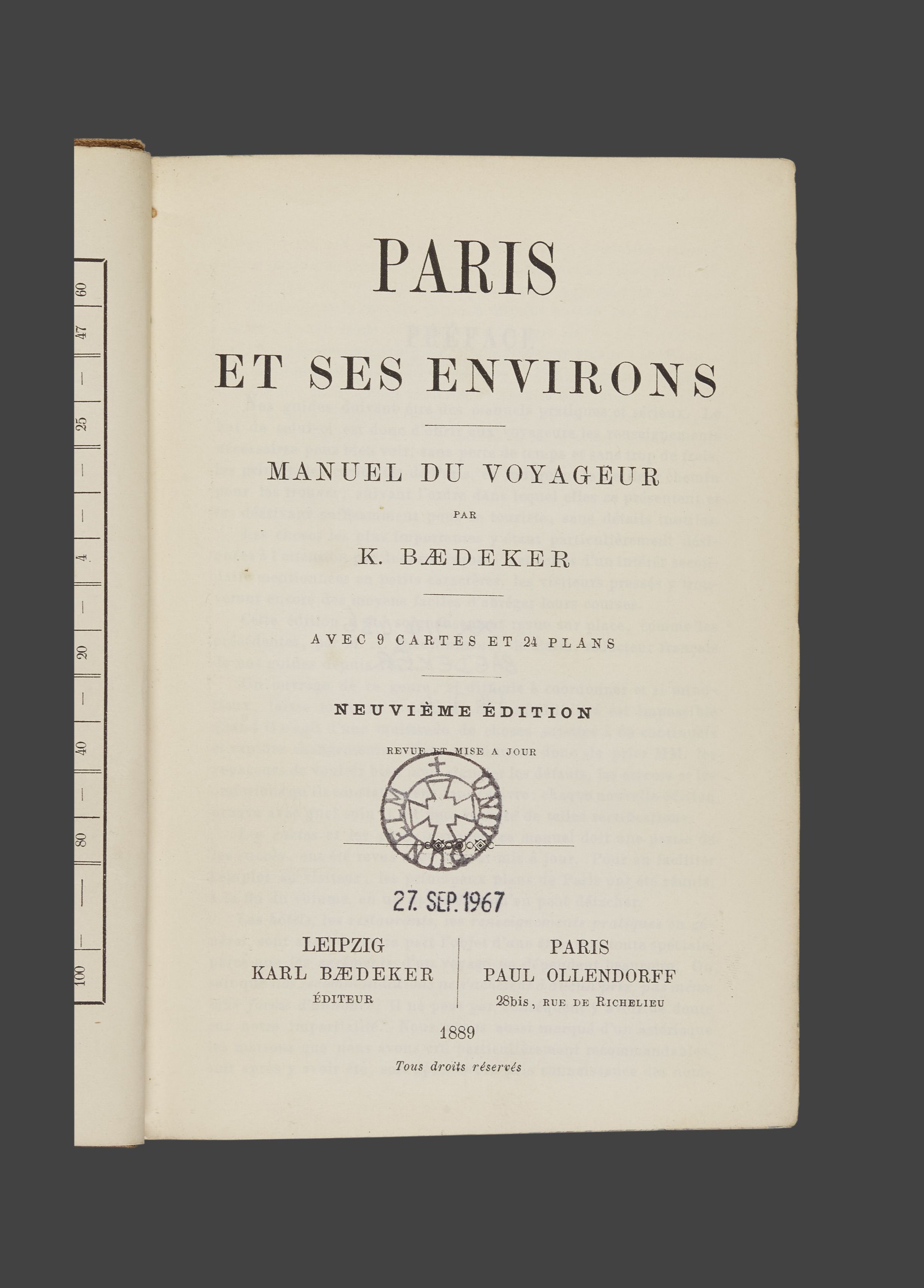
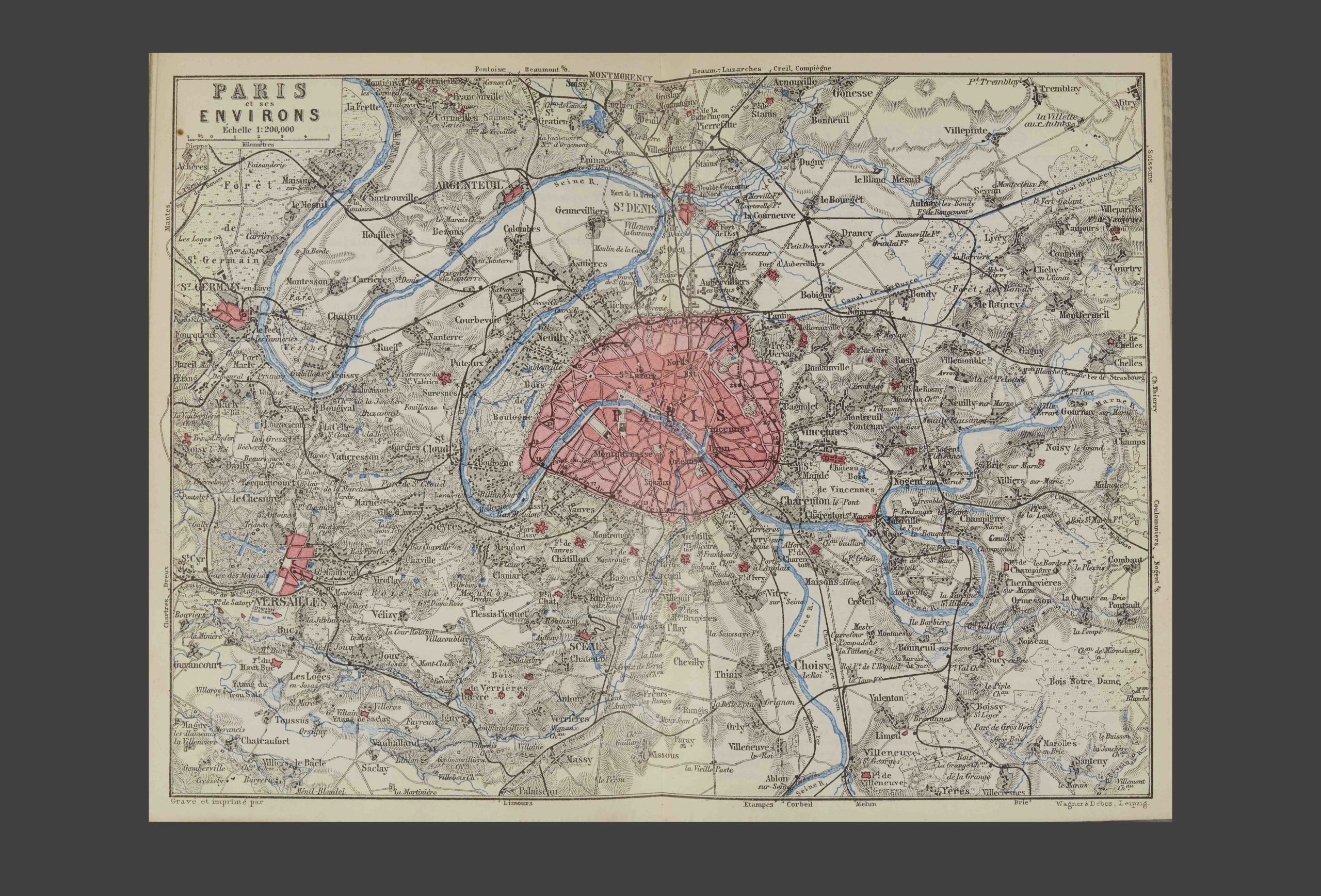

Germain Brice, A new description of Paris. Containing a particular account of all the churches, palaces, monasteries, colledges, hospitals, libraries, cabinets of rarities, academies of the virtuosi, paintings, medals, statues and other sculptures, monuments, and publick inscriptions. With all other remarkable matters in that great and famous city. Translated out of French. London : printed for Henry Bonwicke, at the Red Lyon in St. Paul's Church-Yard, 1687. SB 0650
Germain Brice, A new description of Paris. Containing a particular account of all the churches, palaces, monasteries, colledges, hospitals, libraries, cabinets of rarities, academies of the virtuosi, paintings, medals, statues and other sculptures, monuments, and publick inscriptions. With all other remarkable matters in that great and famous city. Translated out of French. London : printed for Henry Bonwicke, at the Red Lyon in St. Paul's Church-Yard, 1687. SB 0650

Germain Brice, A new description of Paris. Containing a particular account of all the churches, palaces, monasteries, colledges, hospitals, libraries, cabinets of rarities, academies of the virtuosi, paintings, medals, statues and other sculptures, monuments, and publick inscriptions. With all other remarkable matters in that great and famous city. Translated out of French. London : printed for Henry Bonwicke, at the Red Lyon in St. Paul's Church-Yard, 1687. SB 0650
Germain Brice, A new description of Paris. Containing a particular account of all the churches, palaces, monasteries, colledges, hospitals, libraries, cabinets of rarities, academies of the virtuosi, paintings, medals, statues and other sculptures, monuments, and publick inscriptions. With all other remarkable matters in that great and famous city. Translated out of French. London : printed for Henry Bonwicke, at the Red Lyon in St. Paul's Church-Yard, 1687. SB 0650

George Louis Le Rouge, Les curiositez de Paris … ouvrage enrichi d’un grand nombre de figures en taille-douce. Nouvelle edition. A Paris: Chez Saugrain, M. DCC. XLII. [1742]. SC 10575-10576
George Louis Le Rouge, Les curiositez de Paris … ouvrage enrichi d’un grand nombre de figures en taille-douce. Nouvelle edition. A Paris: Chez Saugrain, M. DCC. XLII. [1742]. SC 10575-10576

George Louis Le Rouge, Les curiositez de Paris … ouvrage enrichi d’un grand nombre de figures en taille-douce. Nouvelle edition. A Paris: Chez Saugrain, M. DCC. XLII. [1742]. SC 10575-10576
George Louis Le Rouge, Les curiositez de Paris … ouvrage enrichi d’un grand nombre de figures en taille-douce. Nouvelle edition. A Paris: Chez Saugrain, M. DCC. XLII. [1742]. SC 10575-10576

Handbook for visitors to Paris. Containing a description of the most remarkable objects in the city and its environs, with general advice and information for English travellers in that metropolis, and on the way to it. New and revised edition.London: John Murray; Paris: Galignani, 1882.SCXX 914.436 MUR
Handbook for visitors to Paris. Containing a description of the most remarkable objects in the city and its environs, with general advice and information for English travellers in that metropolis, and on the way to it. New and revised edition.London: John Murray; Paris: Galignani, 1882.SCXX 914.436 MUR

Handbook for visitors to Paris. Containing a description of the most remarkable objects in the city and its environs, with general advice and information for English travellers in that metropolis, and on the way to it. New and revised edition.London: John Murray; Paris: Galignani, 1882.SCXX 914.436 MUR
Handbook for visitors to Paris. Containing a description of the most remarkable objects in the city and its environs, with general advice and information for English travellers in that metropolis, and on the way to it. New and revised edition.London: John Murray; Paris: Galignani, 1882.SCXX 914.436 MUR

Handbook for visitors to Paris. Containing a description of the most remarkable objects in the city and its environs, with general advice and information for English travellers in that metropolis, and on the way to it. New and revised edition.London: John Murray; Paris: Galignani, 1882.SCXX 914.436 MUR
Handbook for visitors to Paris. Containing a description of the most remarkable objects in the city and its environs, with general advice and information for English travellers in that metropolis, and on the way to it. New and revised edition.London: John Murray; Paris: Galignani, 1882.SCXX 914.436 MUR

Paris et ses environs: Manuel du voyageur. Avec 9 cartes et 24 plans. Leipzig: Karl Baedeker; Paris: Paul Ollendorff, 1889. SCXX 914.436 BAE
Paris et ses environs: Manuel du voyageur. Avec 9 cartes et 24 plans. Leipzig: Karl Baedeker; Paris: Paul Ollendorff, 1889. SCXX 914.436 BAE

Paris et ses environs: Manuel du voyageur. Avec 9 cartes et 24 plans. Leipzig: Karl Baedeker; Paris: Paul Ollendorff, 1889. SCXX 914.436 BAE
Paris et ses environs: Manuel du voyageur. Avec 9 cartes et 24 plans. Leipzig: Karl Baedeker; Paris: Paul Ollendorff, 1889. SCXX 914.436 BAE

Paris et ses environs: Manuel du voyageur. Avec 9 cartes et 24 plans. Leipzig: Karl Baedeker; Paris: Paul Ollendorff, 1889. SCXX 914.436 BAE
Paris et ses environs: Manuel du voyageur. Avec 9 cartes et 24 plans. Leipzig: Karl Baedeker; Paris: Paul Ollendorff, 1889. SCXX 914.436 BAE
There is nothing sweeter, nothing pleasanter, nothing
more delightful
than travel.
Hermann Kirchner
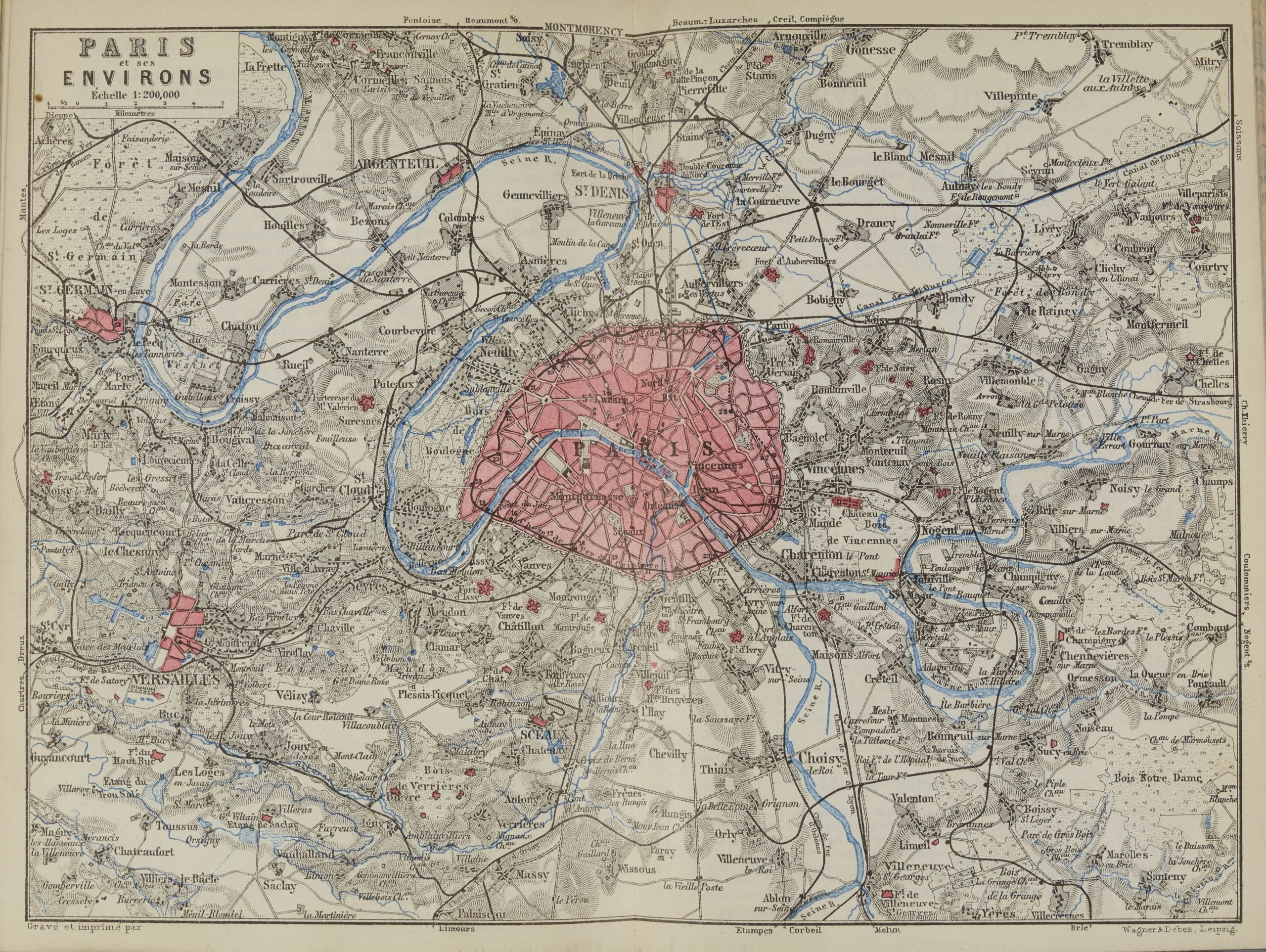
The
Grand Tour
Early guidebooks for the Grand Tour are particularly well represented in the Palace Green Library collections. Wealthy young men most commonly undertook this journey in the 1700s, based on earlier travel itineraries.
The freedom to travel for pleasure has always been a luxury, and the Grand Tour certainly makes this clear. According to many travel writers, this journey through the main sites of Europe, including Paris, Geneva and much of Italy, was a crucial part of a young gentleman’s education, but the length and cost of the Tour meant it was only ever accessible to a privileged few.
Guidebooks like these were written, in part, to quell the criticisms raised about the corruption of the nobility through exposure to foreign cultures, offering structure to the journey and foregrounding its educational merits. These accounts allow us to follow in the footsteps of these lucky travellers, experiencing the wonders of the Grand Tour for ourselves.
Join us as we explore four of the must-see Italian cities of the time, Florence, Venice, Rome and Naples.
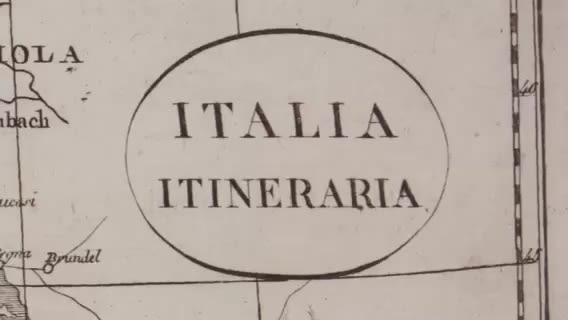
Florence
Cultural enrichment was a crucial aspect of the Grand Tour.
While staying in Florence, a visit to the Uffizi Gallery was essential and Martyn’s guide extensively lists many of the artworks on display. At the time of writing, the Uffizi had been officially opened to the public only recently.
Thomas Martyn, The gentleman's guide in his tour through Italy. London, 1787. SC 14796
Venice
The unique charm of Venice held much the same appeal in the 1700s as it does today. Addison highlights the splendour of Gondola rides on the canals and notes a burgeoning tourist industry selling books and prints.
While describing the many bridges in the city, Addison also makes an observation on the drinking habits of the local population.
Joseph Addison, Remarks on several parts of Italy, &c. in the years 1701, 1702, 1703. London, 1726. SC 07794
Rome
Visiting Rome was the most important stage of any tour through Italy, with travellers often staying for several months to immerse themselves in the ancient sites and visit the many spectacular churches.
This authentic experience of Roman civilisation was an important educational aspect of the tour, though the city clearly held many other appeals, for as the author notes: 'They drink in Rome the best wines'.
Edmund Warcupp, Italy, in its original glory, ruine and revival. London, 1660. Routh 57.C.16
Love this item? Download it as a postcard to send to a friend.
Naples
The Grand Tour would often take travellers as far south as Naples, judged by the author to be one of the most significant cities to visit.
'As for the town itself, of Naples, if it be third of Italy for greatness, it is first for strength and neatness'.
Richard Lassels, The voyage of Italy. Paris, 1670. Routh 59.G.3
Lassels visited Italy before the rediscovery of the archaeological sites at Pompeii and Herculaneum, but visiting nearby Mount Vesuvius and marvelling at its natural wonder was still an important part of the itinerary.
Richard Lassels, The voyage of Italy. Paris, 1670. Routh 59.G.3
Lassels is credited as the first person to refer to the Grand Tour in print, summarising the educational merits of the journey.
Richard Lassels, The voyage of Italy. Paris, 1670. Routh 59.G.3

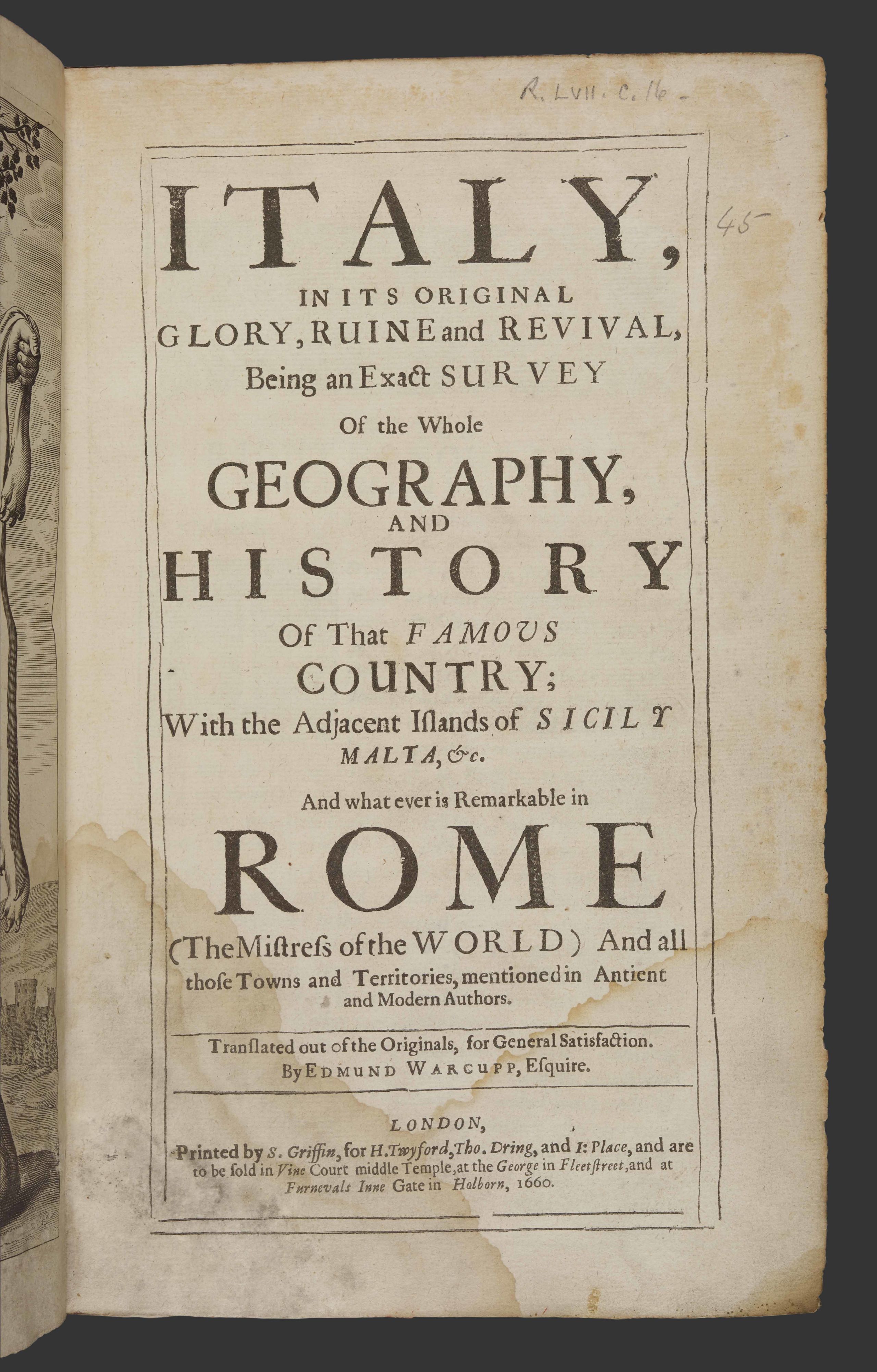
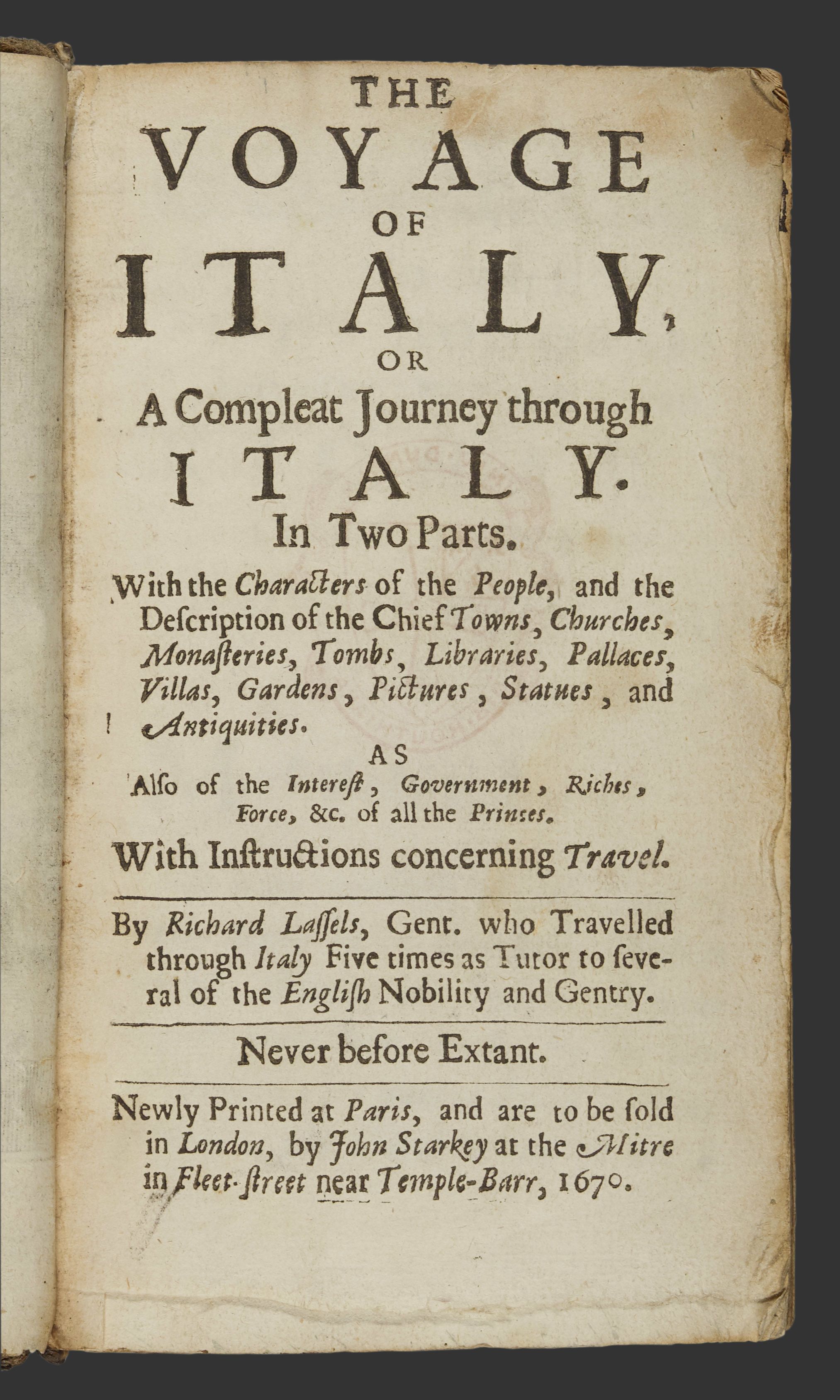
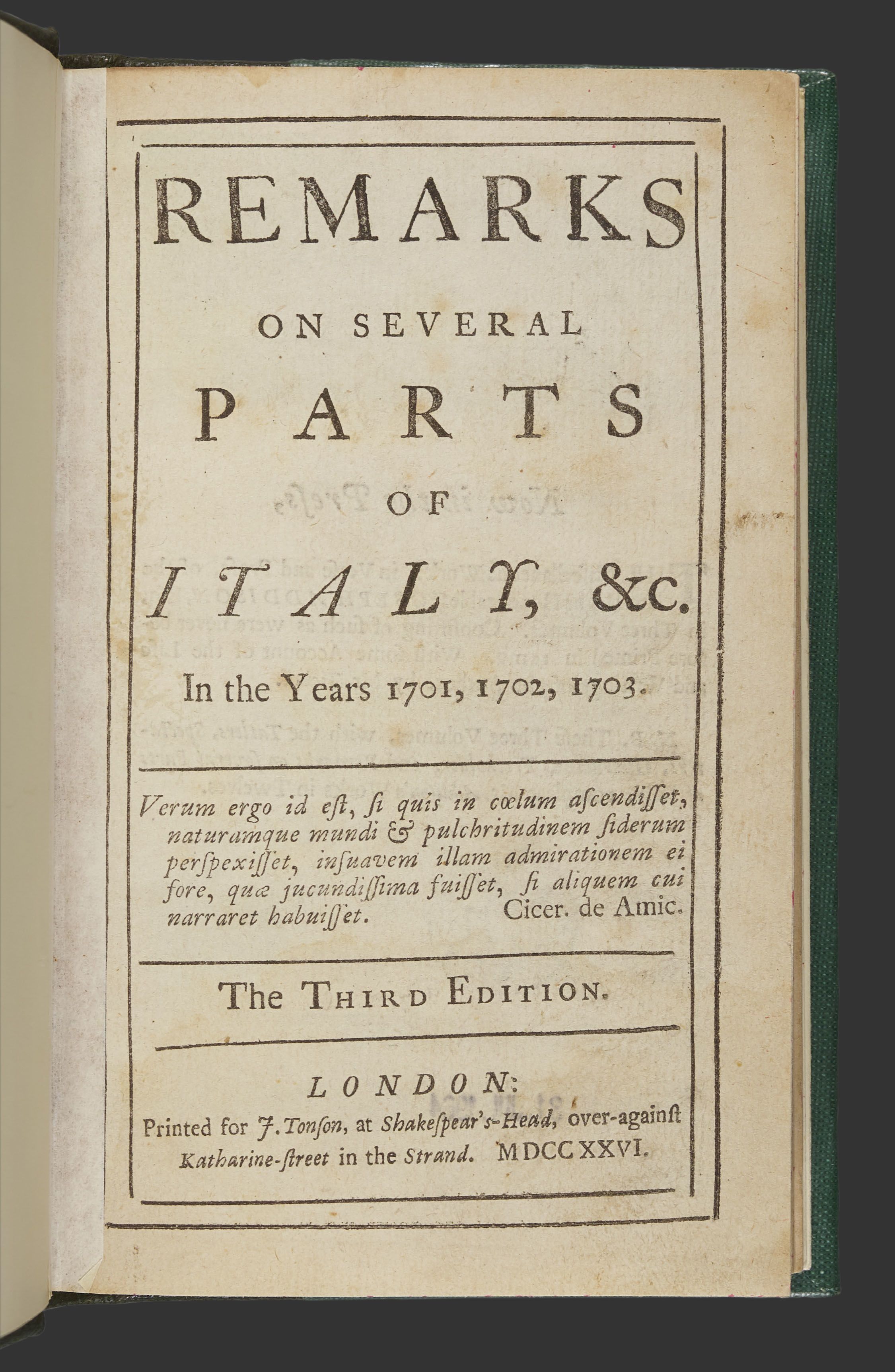
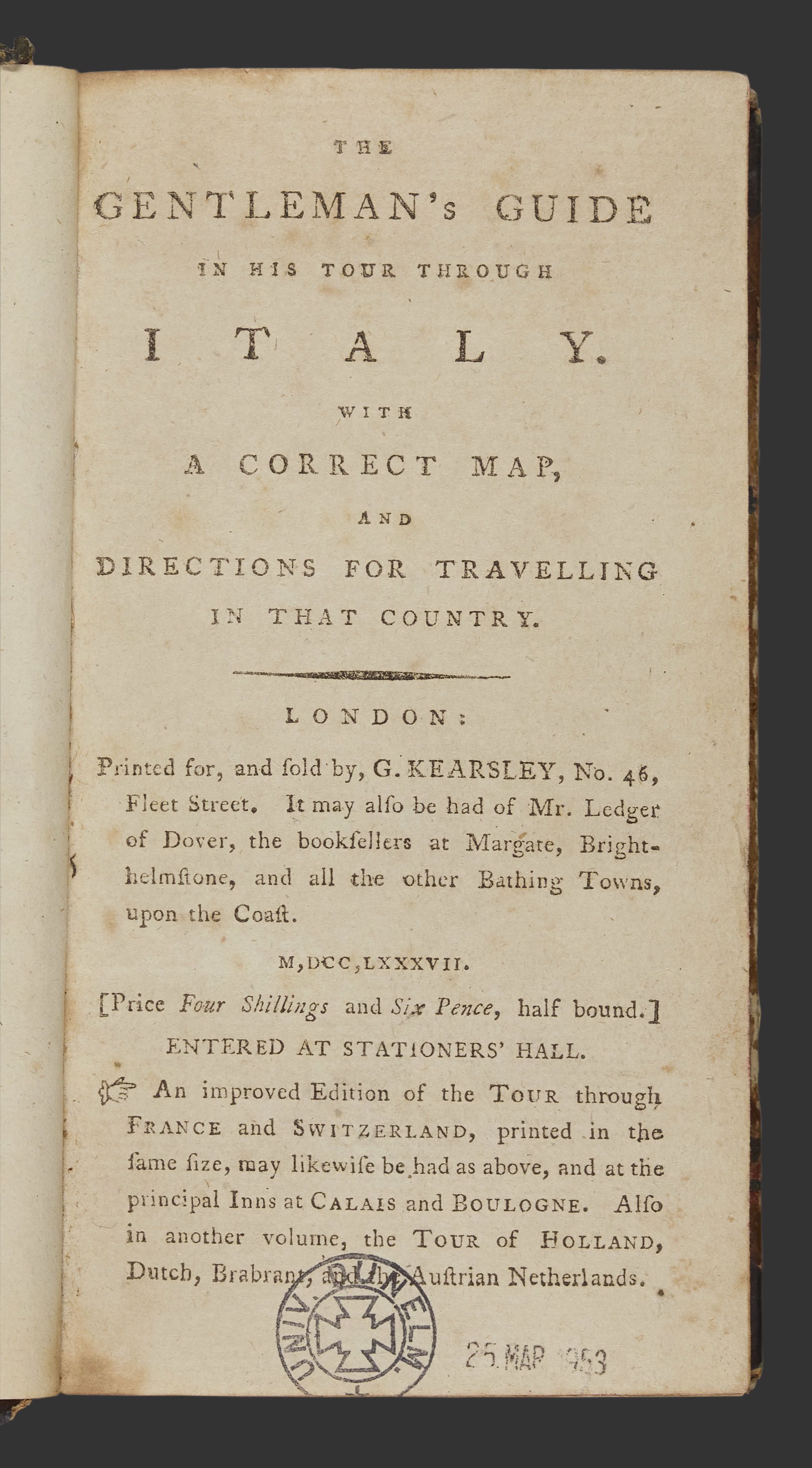
Click here to explore some of the main sites of the Grand Tour in this video produced by Durham University student Faye Thompson, using passages from Martyn's text
Click here to explore some of the main sites of the Grand Tour in this video produced by Durham University student Faye Thompson, using passages from Martyn's text

Edmund Warcupp, Italy, in its original glory, ruine and revival, being an exact survey of the whole geography, and history of that famous country; with the adjacent islands of Sicily, Malta, &c. And what ever is remarkable in Rome … Translated out of the originals, for general satisfaction. London: Printed by S. Griffin, for H. Twyford, Tho. Dring, and I: Place …, 1660. Routh 57.C.16
Edmund Warcupp, Italy, in its original glory, ruine and revival, being an exact survey of the whole geography, and history of that famous country; with the adjacent islands of Sicily, Malta, &c. And what ever is remarkable in Rome … Translated out of the originals, for general satisfaction. London: Printed by S. Griffin, for H. Twyford, Tho. Dring, and I: Place …, 1660. Routh 57.C.16

Richard Lassels, The voyage of Italy, or A compleat journey through Italy. In two parts. With the characters of the people, and the description of the chief towns, churches, monasteries, tombs, libraries, pallaces, villas, gardens, pictures, statues, and antiquities. As also of the interest, government, riches, force, &c. of all the princes. With instructions concerning travel. Newly printed at Paris: and are to be sold in London, by John Starkey at the Mitre in Fleet Street near Temple-Barr, 1670. Routh 59.G.3
Richard Lassels, The voyage of Italy, or A compleat journey through Italy. In two parts. With the characters of the people, and the description of the chief towns, churches, monasteries, tombs, libraries, pallaces, villas, gardens, pictures, statues, and antiquities. As also of the interest, government, riches, force, &c. of all the princes. With instructions concerning travel. Newly printed at Paris: and are to be sold in London, by John Starkey at the Mitre in Fleet Street near Temple-Barr, 1670. Routh 59.G.3

Joseph Addison, Remarks on several parts of Italy, &c. in the years 1701, 1702, 1703. London : printed for J. Tonson, at Shakespear's-Head, over-against Katharine-street in the Strand, MDCCXXVI. [1726]. SC 07794
Joseph Addison, Remarks on several parts of Italy, &c. in the years 1701, 1702, 1703. London : printed for J. Tonson, at Shakespear's-Head, over-against Katharine-street in the Strand, MDCCXXVI. [1726]. SC 07794

Thomas Martyn, The gentleman's guide in his tour through Italy. With a correct map and directions for travelling in that country. London: Printed for, and sold by, G. Kearsley, M, DCC, LXXXVII [1787]. SC 14796
Thomas Martyn, The gentleman's guide in his tour through Italy. With a correct map and directions for travelling in that country. London: Printed for, and sold by, G. Kearsley, M, DCC, LXXXVII [1787]. SC 14796
We hope that you now feel ready for your journey, eager to explore our collections and discover more about the history of travel. If so, you are in luck - we are ready to whisk you away on further adventures.
The next chapters of this exhibition are now available through the link below. Visit to investigate the differences between travellers and tourists and examine the legacies of European exploration. You will also find out more about historic journeys to and from Durham, hear stories of pioneering women travellers and walk the fine line between travel fact and travel fiction.
You can also find out more by following us on social media at the links below.
Facebook Instagram Twitter
Got a minute? Let us know what you think of the exhibition by completing this short survey.
